Nationals Veteran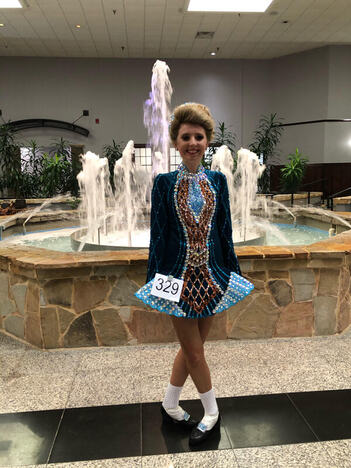 Name: Emily M. Age: 17 Congratulations on qualifying for Nationals! It’s been so long since the last major in November of 2019—what are you most looking forward to this year? I am most looking forward to dancing my absolute best this year, working to incorporate judges feedback with the hopes of improving placement or not getting the same comments each time. Competing with my friends is really important to me as we all support each other as one big extended family. No matter the school, level or the placement at the end of the day, we are always there to support and cheer each other on. I have missed that! You must have changed so much since November 2019! What have you learned over the last year and a half about yourself as a dancer? Since November 2019, I've learned more about my style of dance and complicated choreography that would suit me. I think it's important to take a step back and reevaluate yourself and your dancing to know what you want to achieve in your career. Doing this with the help of Courtney, Christian and Bailey has helped me become more confident in my dances and have created a structured mindset for my goals at majors. What past National competition was your favorite? Why? Nationals 2019 in Vancouver would be my favorite because it was the first year I was eligible to dance. I was so incredibly proud and honored that I was able to go. I had always dreamed of dancing at Nationals and being part of that elite group and it finally came true!! What have you missed the most about competing? (And what have you definitely NOT missed about competing?) I miss competing so much!! My favorite parts of competing would have to be seeing my friends from other schools, being able to showcase what I've worked on and getting judges marks and comments on how to improve. I find the judges marks and teachers' feedback helpful as they have a different perspective on my dances and ways I can improve myself. What’s your proudest dance achievement so far? Any future dance goals you’re setting for yourself? My proudest dance achievement is getting into Open Championships and having the opportunity to go to Nationals. I had always wanted to reach the highest level of irish dance but I wouldn't have gotten this far without hard work, teachers, friends and family. Dancing for fifteen years (irish dancing for twelve!) has taught me the importance of making friends that will last forever and enjoying the moment. Sharing an irish dance journey with my friends is the best thing I could've asked for. In the future I'd love to get the opportunity to compete at Worlds!! What’s your favorite dance to compete in? Which do you think is your strongest? My favorite dance to compete in would be slip jig! I love the elegant and balletic choreography and I love the music too! My strongest dances have always been soft shoe dances just because the energy and flow of each movement suits my dance style. Growing up watching Lord of the Dance and Riverdance had always interested me as the “good girls” would mainly do soft shoe and more specifically slip jigs. Have you ever visited Phoenix before? Any plans while you’re there beyond dancing? I have never visited Phoenix before and I’m looking forward to spending some time there! My Mom and I are planning on making a road trip out of it and going to Las Vegas, San Diego and Los Angeles along the way! As someone who’s been to Nationals before, what’s your advice to dancers competing there for the first time? My first Nationals was nerve wracking as I didn't know what to expect and became overwhelmed. So my advice to those who are going for their first time this year is to just have fun and remember that you earned a spot to be there. When I first went I put so much unnecessary stress on myself and believed that I didn't belong. If you go into it with a good attitude, belief in your teachers and have a good mindset, you're ready to reach success. Remember to enjoy your moment and do YOUR personal best. The rest is out of your hands. ☘️ This post is part of a series. Take a look at our last Nationals Spotlight, with Gabby G. and Kellyann, here. Also: check out the blog every Monday and Thursday for more posts about Irish history, dance culture, community news, and spotlights on our dancers, staff, and families—among other fun projects! And don’t forget to dance along with us on both Facebook and Instagram
0 Comments
2020 Qualifier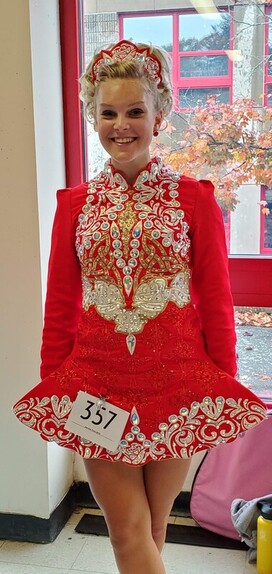 Name: Gabby G. Age: 17 Congratulations on qualifying for Nationals back in 2020! I know it must have been disappointing when last year was cancelled, but do you think this extra time has made you a stronger competitor? What have you learned about yourself as a dancer this last year? I think dancing online was difficult for all of us, but I definitely think having the extra time to practice and learn steps has been really beneficial. Something that I have learned about myself is that I actually do have the creative mental capacity to re-choreograph a part of my step that had been giving me trouble. Choreographing steps in the past has been nearly impossible for me, but I was really proud of myself that I could successfully add in a piece of my own stylistic choices into my dancing. What are you most looking forward to about Nationals? I am looking forward to the atmosphere and just being somewhere new with some of my best friends. What have you missed the most about competing more regularly this year? (And what have you definitely NOT missed about competing?) Something I definitely have not missed about competing are the wigs and the fake tan. I did miss the dresses and the running around the venue finding friends and watching other competitors dance a little bit, though. What’s your proudest dance achievement so far? Any future dance goals you’re setting for yourself? I think my proudest dance achievement is not really any specific award/placement, but how far I have come. I have collected a number of videos from practices of my dances and even just in a year, I can see how much some of my technique has improved. My goal for this Nationals is to try my best to not be shaken by the number of strong competitors. Have you ever visited Phoenix before? Any plans while you’re there beyond dancing? I don’t think I have ever visited Phoenix, though a couple of years ago my family took a trip around different national parks in Arizona. I am most likely just going with my mom, but we both love hiking, so after I dance, I think the two of us will be out hiking a lot during this trip. What’s your favorite dance to compete in? Which do you think is your strongest? I don’t know what it is about soft shoe, but whether it be slip jig or reel, I absolutely love it and I think that this will most likely translate into my dancing at Nationals. What advice would you give a dancer hoping to qualify for Nationals? My advice would be to set goals and don’t stop until you’ve reached them. For every competition, whether it be a major or just a regular competition, I always set goals for myself and practice hard at dance and at home. 2020 Qualifier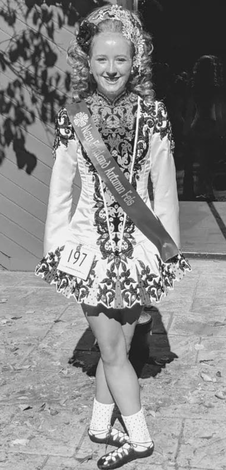 Name: Kellyann Age: 16 Congratulations on qualifying for Nationals back in 2020! I know it must have been disappointing when last year was cancelled, but do you think this extra time has made you a stronger competitor? What have you learned about yourself as a dancer this last year? Over the past year I have grown both mentally and physically as a dancer. This past year has been particularly challenging for me with the pandemic and ankle surgery in December, but the experiences ultimately grew my love for dance even more, which I did not know was possible. The additional year has given me more time to become even more motivated, in addition to granting me another perspective on the accomplishment of making it to Nationals. I have learned that when I put my mind to something anything is possible. What are you most looking forward to about Nationals? I am looking forward not only to spending time with some of my favorite people in the world, all my fellow SRL National Qualifiers, but to achieving my ultimate goal from when I started Irish dance, dancing on the stage at Nationals. What have you missed the most about competing more regularly this year? (And what have you definitely NOT missed about competing?) I have missed seeing all of my feis friends, who do not attend SRL, in addition to the feeling of being on stage. I definitely have not missed the early morning, bobby pins, and wigs over the past year. What’s your proudest dance achievement so far? Any future dance goals you’re setting for yourself? My proudest dance achievement would be my Preliminary Championship first place at the Shamrock Feis, but I also am overjoyed by my ability to return to dance 3 ½ months post-op. My future goals for irish dance include qualifying for Open Champ, and recalling at Oireachtas for solos. Have you ever visited Phoenix before? Any plans while you’re there beyond dancing? I have never been to Phoenix before. We are planning to spend time with my cousins who are also competing this year and exploring the area around the convention center. What’s your favorite dance to compete in? Which do you think is your strongest? I love competing in reel, but I think that slip jig is usually my strongest dance. What advice would you give a dancer hoping to qualify for Nationals? Do not give up, and do not get discouraged. If you have an unideal placement at a feis use the comments and experience to grow. Come to the next class ready to listen, acknowledge, and strive to correct your comments. With that being said do not let the placements define you and remember that you do Irish dance because you love it. This post is part of a series. Take a look at our last Nationals Spotlight, with Balian and Kayla P., here. Also: check out the blog every Monday and Thursday for more posts about Irish history, dance culture, community news, and spotlights on our dancers, staff, and families—among other fun projects! And don’t forget to dance along with us on both Facebook and Instagram. 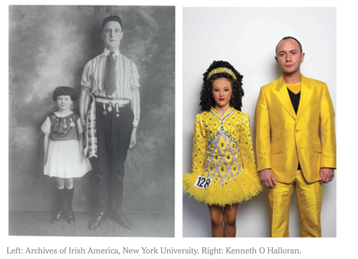 The early 1990s versus the early 2000s The early 1990s versus the early 2000s The Look, Part 4: Male Costuming Fashion, in or out of the dance world, has long been a female-dominated realm. However, while that means male Irish dancers have had significantly less changes over the years, they haven’t completely escaped the glamification of their costumes! Today we’ll take a look at that evolution and how our current expectation for male Irish dance costuming came to be. 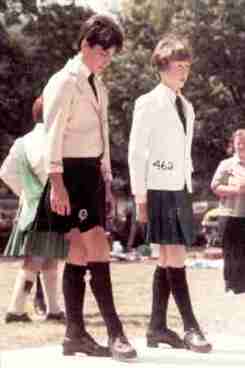 Kilts were worn commonly into the 90s, especially as school costumes Kilts were worn commonly into the 90s, especially as school costumes While we know from our first installment (catch up here) that most Irish dancers started by dancing in their regular clothes, men’s costuming actually appears to predate women’s. Dance masters were typically male, and as they often dressed flamboyantly to help drive business, they were known by their fancy hats, swallowtail coats, breeches, white stockings/socks, and shiny, silver-buckled shoes. Due to British rules and restrictions (the impact of which was felt for 100s for years,) most male dancers simply wore their “Sunday Best” as their female counterparts did—typically a shirt and tie with breeches tucked into knee socks, a cummerbund around the waist. Similarly to female trends, as time passed there was a focus on traditional Irish fabrics and designs. For instance, in 1904, at the first Glens Feis in Glenarriff, Co. Antrim, the first prize for one of the competitions was: “a suit of Irish Homespun, presented by Hamilton and Co. Portrush, Co. Antrim.” While kilts as a male clothing item is associated in our modern minds with Scotland, Irish dance has always been about the feet, so kilts became a typical item dancers (male and female!) wore for many years (largely from the 1910s to the 1960s.) Pipers first wore them, but as Irish dance and music are completely intertwined, the dancers eventually adopted the look at well. (If you check our previous post about Irish dance shoes, you’ll find Ireland and Scotland are intertwined in many aspects of their dance traditions!) Kilts were typically worn with a short coat and brat/cape (the male version a bit shorter and usually attached to the front of the coat with a Celtic design brooch—they’re a holdover from times of rebellion,) along with shirt, tie, and knee socks. These days, boys still have the option to wear a kilt, but since premiere of Riverdance in 1994, pants have gradually become the norm. Male dancers typically wear long (black) pants (though very young dancers sometimes perform in short pants,) a shirt, and often a vest and tie. For many years, it was a trend for male dancers to emulate the sparkling, bright dresses of the female solo dancers through their vests and ties. However, in recent times there’s been a movement toward more sleek, sophisticated looks rather than full on sparkle all the time! 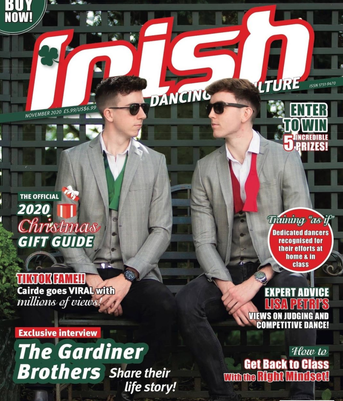 The Gardiner Brothers’ viral tiktoks have influenced a more cool, casual look for male Irish dancers in the last few years (doesn’t hurt they have 5 World Championships between them!) The Gardiner Brothers’ viral tiktoks have influenced a more cool, casual look for male Irish dancers in the last few years (doesn’t hurt they have 5 World Championships between them!) And that’s a wrap on our series all about the whys and hows of Irish dance’s iconic look came to be! One of the most exciting things about being part of the Irish dance community is just that—it’s a community that is growing and evolving, changing as its influence spreads across the globe. You don’t have to be Irish to do Irish dance, but by entering the world of Irish dance you’re becoming a part of a living tradition that both honors the past while moving forward into the future. Through wigs, kilts, and beyond! This post is part of a series. Take a look at our last “Origins of Irish Dance” post, all about modern female costuming, here. Also: check out the blog every Monday and Thursday for more posts about Irish history, dance culture, community news, and spotlights on our dancers, staff, and families—among other fun projects! And don’t forget to dance along with us on both Facebook and Instagram. 2020 Qualifier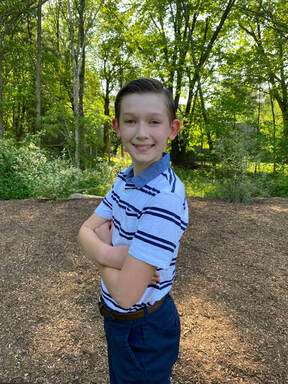 Name: Balian Age: 11 Congratulations on qualifying for Nationals back in 2020! I know it must have been disappointing when last year was cancelled, but do you think this extra time has made you a stronger competitor? What have you learned about yourself as a dancer this last year? I am disappointed I couldn't go to Tennessee, but I definitely think I am more prepared this year and a much stronger dancer. I feel I have much more stamina this year and my steps are more interesting to perform. This year, I have learned that doing fitness circuits has made my posture stronger. What are you most looking forward to about Nationals? I am looking forward to going to Arizona because it will be a new place to explore, and I am most looking forward to being up on stage. It's an amazing feeling! What have you missed the most about competing more regularly this year? (And what have you definitely NOT missed about competing?) I have missed seeing other dancers and I have missed the excitement of competition. Also, being a string player, I always enjoy live music. I have definitely NOT missed walking around feis hallways with girls crying everywhere. What’s your proudest dance achievement so far? Any future dance goals you’re setting for yourself? My proudest dance achievement was winning 2nd place at Oireachtas and qualifying for 2020 Nationals. My future dance goal is a secret, but Christian knows it. Have you ever visited Phoenix before? Any plans while you’re there beyond dancing? Never been to Phoenix, but my dad and brother are making some surprise plans for when my competition is over. What’s your favorite dance to compete in? Which do you think is your strongest? I LOVE reels because I feel like I'm flying and I love the happiness of it. I think I am strong at reels because I love clicking in my reel shoes and I think I move well around the stage. What advice would you give a dancer hoping to qualify for Nationals? Make good use of circuits and workouts because your whole body needs to be strong, not just your legs! Nationals Veteran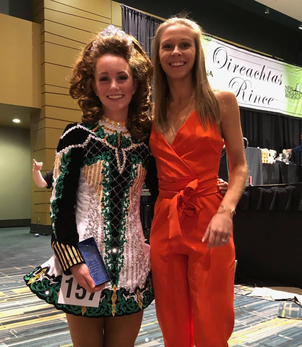 Name: Kayla P. Age: 18 Congratulations on qualifying for Nationals! It’s been so long since the last major in November of 2019—what are you most looking forward to this year? I am mostly looking forward to traveling for a competition again and all the memories that come along with that. You must have changed so much since November 2019! What have you learned over the last year and a half about yourself as a dancer? I have learned that competing is not the main reason I love dancing so much, but rather just working hard and hanging out with friends. What past National competition was your favorite? Why? Vancouver! I recalled for the first time and I love Canadians! What have you missed the most about competing? (And what have you definitely NOT missed about competing?) I have missed spending the weekends with my mom and friends the most—and seeing progression in my dancing through marks and comments. I have not missed quick shoe changes and taping my shoes! What’s your proudest dance achievement so far? Any future dance goals you’re setting for yourself? World qualifying! And nothing too major, I’m more focused on enjoying my senior year of dance and dancing my absolute best at Nationals. What’s your favorite dance to compete in? Which do you think is your strongest? Reel! And reel or set. Have you ever visited Phoenix before? Any plans while you’re there beyond dancing? Nope! I hope to see the cool rocks. As someone who’s been to Nationals before, what’s your advice to dancers competing there for the first time? Enjoy it! Focus on yourself and all the hard work you have done leading up to this point. Take a big deep breath before stepping on stage and smile. This post is part of a series. Take a look at our last Nationals Spotlight, with Spicey and Bella J., here. Also: check out the blog every Monday and Thursday for more posts about Irish history, dance culture, community news, and spotlights on our dancers, staff, and families—among other fun projects! And don’t forget to dance along with us on both Facebook and Instagram. 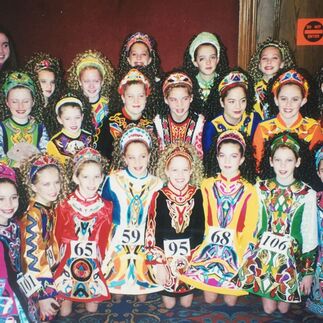 The 1990s were all about going BIG The 1990s were all about going BIG The Look, Part 3: Modern Female Costuming Last week, we were able to make it into the 20th century, but this week we’re breaching the 21st with our discussion of Irish dance female costuming in the modern age! (Catch up on the history here and here.) For our purposes, the modern age of Irish dance is also the competitive age (though the tradition of feiseanna is, of course, a much, much older one!), starting with the establishment of the Irish Dance World Championships in 1970. The formation of this competition forced more rules and regulations into being regarding costuming and gathered together dancers from all over the world in one place—meaning trends were also able to take off. Even in the 1960s, a certain look had been established within Ireland and the trends of bouncy, curled hair (a long-ago Sunday church staple,) brightly colored dresses, and (eventually) deeply tanned legs (in a largely pale-skinned country) spread quickly. 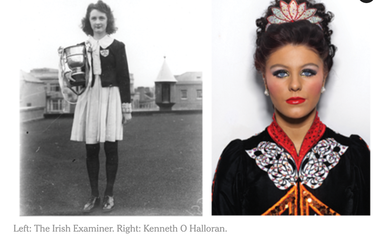 The early 1900s versus the early 2000s The early 1900s versus the early 2000s But it wasn’t until the 90s that the current “look” of Irish dance really took off. Riverdance’s highly theatrical and flashy style not only brought Irish dance to the world’s attention, it also altered the Irish dance world. While Riverdance (the influence of which we’ll discuss more fully in another installment) actually didn’t use traditional Irish dance looks in the show, but rather took a more multi-cultural approach, the showmanship had its effects. Like much in the 90s, dresses got brighter and more sparkly, the wigs got bigger, and theatricality and pageantry became a part of the performance—as the sport grew in popularity, so did dancers’ needs to stand out among the competition. It would be hard to discuss modern, female costuming in Irish dance without bringing up its controversies. The use of fake tan—which is perhaps falling out of favor, but had been a staple of the competitive Irish dance circuit and Irish culture for decades—and makeup, as well as the often extraordinary cost of solo dresses and wigs has come under fire in recent years. Films and documentaries about other forms of dance, such as Cuties (which U.S. Netflix had to remove after an uproar from their audience,) have increased this outcry, while technology’s rapid advancements in the last two decades have left parents fearful their children aren’t given the chance to be children anymore. However, the first thing to note is this: “the look” of an Irish dancer isn’t compulsory, for the most part. Rules are even in place to discourage younger dancers from growing up too quickly--makeup isn’t allowed by the CLRG on dancers 10 or younger. Chances are your female dancer may be getting interested in makeup by 11 on their own—but even then, the heavy makeup used for competitions is part of the costume, necessary for judges to see a dancer’s face clearly under the hot performance lights, and part of all forms of performance for both genders as far back as records go. As far as fake tan goes, there’s no real reason for its prevalence beyond perhaps helping a dancer stand out and maybe look stronger, but natural looks have been have been coming back into fashion (and may go out in favor again—that’s what fads do!) 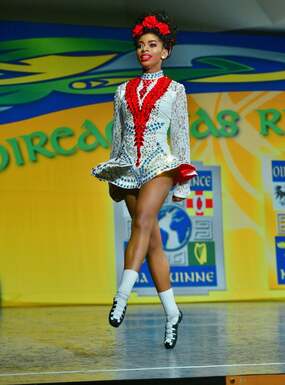 While still high on glitz, modern Irish dance solo dresses are a little less garish than their predecessors While still high on glitz, modern Irish dance solo dresses are a little less garish than their predecessors The main complaint from parents about many other forms of dance—oversexualization in dance moves—is one Irish dance steers clear away from. Irish dance’s steps may not be exactly what the Druids were doing around their bonfires, but they stem from quite literally ancient traditions and a deeply rooted and hard-won culture. There’s a gravity to Irish dance’s tradition and history that Irish dance’s costuming chooses to celebrate rather than cover up with the bright colors and many rhinestones, the tiara and bejeweled clips for capes and entry numbers (though there is a move to return to Celtic designs, like the more classic Tara brooch.) And while costuming throughout the dance world is also often (perhaps sometimes fairly) criticized, Irish dance’s costumes don’t fall under that category. Though the skirts may be short to better show the dancer’s only moving body parts, they’re generally very heavy fabrics, with long sleeves and often required to cover the collarbones, as well. Their expense is undeniable—though with the advent of computerized embroidery at home (among other innovations) and the continued increase of interest in the sport is helping to drive solo dress prices down—but they still cling to the roots of tradition with Celtic designs and influences. Irish dance, while loved worldwide, is still a somewhat insular community. However, it’s still a community! That means not every dress has to be brand new--the secondhand Irish dance solo dress market is a buzzing one! Last question I know is burning the tip of your tongue: why the wigs? The answer is simple: it’s easier and more restful than sleeping in rollers! Curled hair was synonymous with “dressed up” in Ireland for many years, and the bouncy curls as part of a dancer’s look has a far longer tradition than anything else they're wearing! Eventually, dancers simply got sick of being uncomfortable the night before a big competition, and switched over the wigs instead—which allowed for bigger and bigger hair. While styles have transitioned into lighter, curled buns and shorter, less heavy, curled wigs, it’s again part of the theatrical look and doesn’t seem to be going anywhere anytime soon! Don’t worry, boys, we didn’t forget about you! Tune in next week for the last part of our Irish dance costuming series: all about the evolution of the male dancer’s costumes throughout the ages. This post is part of a series. Take a look at our last “Origins of Irish Dance” post, all about both male and female hard and soft shoes, here. Also: check out the blog every Monday and Thursday for more posts about Irish history, dance culture, community news, and spotlights on our dancers, staff, and families—among other fun projects! And don’t forget to dance along with us on both Facebook and Instagram. Nationals Debut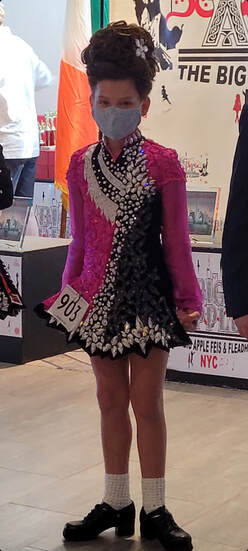 Name: Isabella “Spicey” R. Age: 10 Congratulations on qualifying for Nationals for the first time! What an amazing achievement—how does it feel to see all your hard work in the studio and at competitions pay off? What does achieving this goal mean to you? It feels really good and it just means I am doing very well. This past year must have been one of progress for you, what have your learned about yourself as a dancer in that time? That I am capable of more than I think I am. What are you most looking forward to about going to Nationals? I am most looking forward to just being there as a dancer and dancing my best. What’s your favorite dance to compete in? Which do you think is your strongest? I like dancing my Slip Jig the best. I think my strongest dance is my Set. What have you missed the most about competing more regularly? (And what have you definitely NOT missed about competing?) What I have missed most about competing is having a good time with my mom and bringing home a nice award. The thing I have not missed is having to do my wig. What’s your proudest dance achievement so far? Any future dance goals you’re setting for yourself? My proudest dance achievement is probably earning my solo dress and being invited to nationals. My future goals are earning my buckles and going to Worlds. Have you ever visited Phoenix before? Any plans while you’re there beyond dancing? No, and my plans are to have a good time with my Mom and Godmother and buy a cactus. What advice would you give dancers just starting to compete? Never be nervous and always have a proud smile on your face. Sometimes it's not your turn to win. Nationals Veteran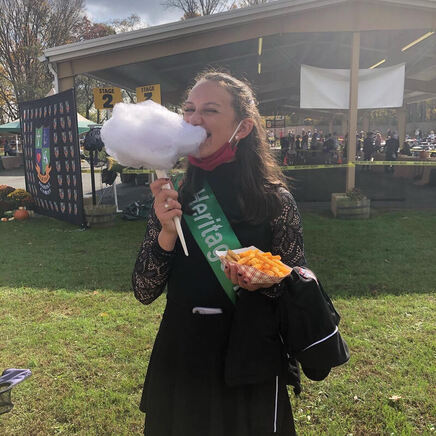 Name: Isabella "Bella" J. Age: 14 Congratulations on qualifying for Nationals! It’s been so long since the last major in November of 2019—what are you most looking forward to this year? I am looking forward to traveling. You must have changed so much since November 2019! What have you learned over the last year and a half about yourself as a dancer? I have learned that you can dance anywhere. What past National competition was your favorite? Why? My favorite nationals was Orlando because I got to go to Disney. What have you missed the most about competing? (And what have you definitely NOT missed about competing?) I have missed being able to see my friends. I haven’t missed having to do my hair. What’s your proudest dance achievement so far? Any future dance goals you’re setting for yourself? My proudest achievement was recalling at Oireachtas 2019. I’d like to recall at nationals. What’s your favorite dance to compete in? Which do you think is your strongest? My set is my favorite dance to compete in. I feel that my set is the strongest. Have you ever visited Phoenix before? Any plans while you’re there beyond dancing? No I have never visited Phoenix before. My family and I plan to go to the Grand Canyon and do other touristy things! As someone who’s been to Nationals before, what’s your advice to dancers competing there for the first time? My advice is don’t be nervous it’s just another day dancing. This post is part of a series. Take a look at our last Nationals Spotlight with Maggie S. and Collen W., here. Also: check out the blog every Monday and Thursday for more posts about Irish history, dance culture, community news, and spotlights on our dancers, staff, and families—among other fun projects! And don’t forget to dance along with us on both Facebook and Instagram. 2020 Qualifier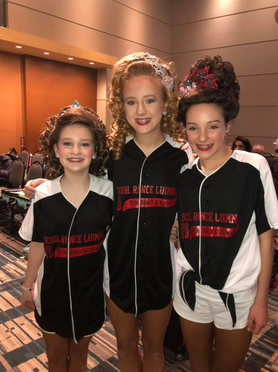 Name: Maggie S. Age: 13 Congratulations on qualifying for Nationals back in 2020! I know it must have been disappointing when last year was cancelled, but do you think this extra time has made you a stronger competitor? What have you learned about yourself as a dancer this last year? I think that this extra time has been super helpful for me. It has given me lots of time to improve and build my stamina. This year made me realize how much I value dancing in-person, with friends to cheer me on, because online dance was a challenge! What are you most looking forward to about Nationals? I am looking forward to the experience of dancing with very advanced dancers, and being able to have fun with friends!! What have you missed the most about competing more regularly this year? (And what have you definitely NOT missed about competing?) I have missed the familiarity of dancing on stage in front of others, but I haven't missed the stress and pressure!! What’s your proudest dance achievement so far? Any future dance goals you’re setting for yourself? My biggest dance achievement is winning Trad-Set at the Oireachtas!! I hope that by the time I am done dancing, I will World Qualify!! Have you ever visited Phoenix before? Any plans while you’re there beyond dancing? I haven't, and I'm going to Sedona with friends!! What’s your favorite dance to compete in? Which do you think is your strongest? I think my Set dance is my strongest, but I enjoy doing Reel the most because it's upbeat and lively! What advice would you give a dancer hoping to qualify for Nationals? I would tell people who wish to qualify for Nationals that they should remember to keep a positive mindset. This year has been tough, but I feel like half the reason I have improved is because I believe in myself and have confidence in my dancing. Nationals Veteran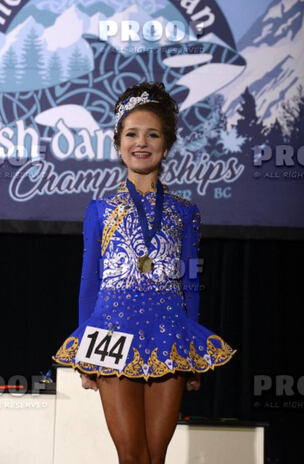 Name: Colleen W. Age: 14 Congratulations on qualifying for Nationals! It’s been so long since the last major in November of 2019—what are you most looking forward to this year? Being on the big stage again. You must have changed so much since November 2019! What have you learned over the last year and a half about yourself as a dancer? One dance day does not define your entire dance career. What past National competition was your favorite? Why? Vancouver 2019, it was my first recall. What have you missed the most about competing? (And what have you definitely NOT missed about competing?) I missed seeing my friends from other schools and I did not miss doing my wig. What’s your proudest dance achievement so far? Any future dance goals you’re setting for yourself? My proudest achievement is recalling at nationals and I hope to do it again, What’s your favorite dance to compete in? Which do you think is your strongest? My favorite is my set and I also think its my strongest. Have you ever visited Phoenix before? Any plans while you’re there beyond dancing? I’ve never been before, I plan to go to the Grand Canyon. As someone who’s been to Nationals before, what’s your advice to dancers competing there for the first time? Don’t stress about it, just think about having fun. This post is the first of a series. Check out the blog every Monday and Thursday for more posts about Irish history, dance culture, community news, and spotlights on our dancers, staff, and families—among other fun projects! And don’t forget to dance along with us on both Facebook and Instagram. 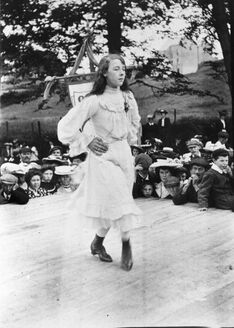 An Irish dancer performing in 1904 in her “Sunday Best” An Irish dancer performing in 1904 in her “Sunday Best” The Look, Part 1: Female Costuming History For many people, all they know of Irish dance is one thing: what a female, competitive soloist looks like. Big, curled hair, lots of makeup, maybe some fake tan on the legs, and, above all: a short, elaborate, bedazzled dress like nothing else in the dance world (or outside of it!) Like anything that’s such a consistent part of our cultural consciousness, we don’t necessarily think to ask the question: why? Why and how did the look we know today for Irish dancers come to be? With Ireland’s tradition of oral history, we don’t know quite how far back the tradition of Irish culture festivals (singular: feis (fesh) or plural: feiseanna) truly goes, but once the records start in the late 19th century, one thing is clear: there were no rhinestones involved. Feiseanna were a celebration of Irish culture, and Irish dancers didn’t have a particular look except that everyone always came in their Sunday best—generally ankle-length dresses, often white, lace-up boots, and with bouncy, curled hair to look their best—sometimes fashioning flowers or crosses made of ribbon to add decoration. However, the dancers eventually wanted their costumes to reflect their culture too! 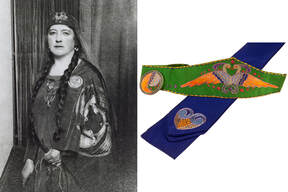 Claire Kennedy, wife of the former Irish Attorney General, in Celtic Revival costume Claire Kennedy, wife of the former Irish Attorney General, in Celtic Revival costume Lasting from about 1885 until the 1930s, the Celtic Revival spread Irish culture not just across Ireland, but internationally, particularly in the production of textiles and ornamental brooches with designs dating back to the 1500s. During this time period, Irish dancers favored handmade, crocheted lace, handcrafted embroidered items in Celtic patterns, as well as pins with elaborate Celtic knots and scrolls that we still see on dancers today (often holding their competitor’s number!) 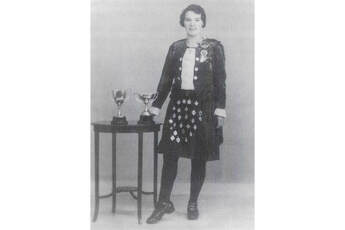 Peggy O’Neil in 1940—note the apron with her many winning medals, which were only worn for photographs Peggy O’Neil in 1940—note the apron with her many winning medals, which were only worn for photographs In the 1930s, with the forming of the CLRG (the main governing body of Irish dance to this day,) we started solidifying the concept of “costuming” within the Irish dance world. 8th century designs began to be favored, with reproductions of early Irish dress a precursor of what’s still Irish dance costume today, including a long tunic with dramatic sleeves (a leine) and a cape (a brat,) as well as handmade lace collars and cuffs. These items were often wrought of handwoven tweed and other handmade fabrics and designs that took inspiration from the famed Book of Kells and ancient, stone Celtic crosses and monuments. Skirts also began to creep up to the knee during this time period to better allow the dancers’ feet to be seen. 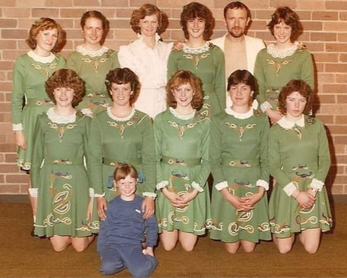 Vintage school costumes via @once_upon_a_feis on Instagram. Note the lace collars and cuffs! Vintage school costumes via @once_upon_a_feis on Instagram. Note the lace collars and cuffs! With the rise of Irish dance schools across Ireland and America (among other countries) in the 1940s, these costumes began to split the difference between historic and modern, transforming into something representative of the school and the Irish tradition behind the art. Touring companies of Irish dancers drew crowds in American cities who were nostalgic for their homes, as the costuming reminded them of historic peasant dress or Celtic artwork. Schools began to dress their dancers in matching school costumes and colors, favoring Kelly green, white, and gold most heavily. Until the modern era, red was considered too English and most schools didn’t utilize it (making SRL’s colors all the more distinctive now!) Tune in next week for a look at the evolution of most important part of any Irish dancer’s look: the shoes! This post is part of a series. Take a look at our last "Origins of Irish Dance" post, all about levels and competitions, here. Also: check out the blog every Monday and Thursday for more posts about Irish history, dance culture, community news, and spotlights on our dancers, staff, and families—among other fun projects! And don’t forget to dance along with us on both Facebook and Instagram. 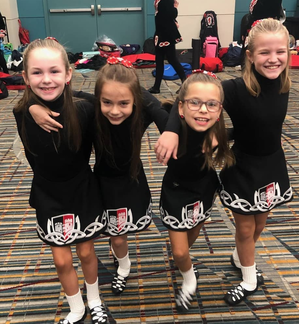 SRL dancers in their school skirts at the 2019 New England Oireachtas SRL dancers in their school skirts at the 2019 New England Oireachtas Levels and Competitions, Part 3 Many of our parents and dancers here at SRL are fully aware of all the ins and outs of Irish dance, and this post isn’t really for them (unless they’ve always been a little fuzzy on some of it—we won’t tell! It’s complicated!) This post is for our up and coming dancers who are excited about competing more regularly. If you’re a Beginner, still learning the ropes, or checking out our website for the first time, check out the six previous posts in the series to catch you up to the present in Irish dance’s history! Regional Oireachtas to Worlds Irish dance’s prevalence these days isn’t simply a case of respect for the intricate footwork, perfect balance, and incredible stamina and grace it takes to make an Irish dancer, it’s a type of cultural exchange that expands the diaspora of the Irish people. Whether you’re of Irish heritage or not, participating in or watching Irish dance brings you a little closer to a country with a complex and rich history. It’s no surprise that the CLRG (the main governing body of Irish dance, based in Ireland) now have records to indicate “that Irish dancing is practiced in countries as far afield as Japan, Brazil, Argentina, South Africa and at an ever-growing rate in Eastern Europe.” Not to mention North America! In our previous two installments, we discussed the foundation of competitive Irish dance: the role of feiseanna (pronounced fesh-anna, the plural of feis i.e. fesh) and the different types of dances performed at these festival competitions (with corresponding music and at varying levels as your technique and skill develop.) But feiseanna are only the local level of the competitive Irish dance circuit. The next step? Time to move up to an Oireachtas competition! (At your teachers’ and parents’ discretion, of course!) The term “Oireachtas” (pronounced o-rock-tus, but say it quickly!) denotes a regional competition (as opposed to a local feis) that can be as broad as a whole section of the country, though the way your day goes will look much like a feis. Fun fact: as the word oireachtas roughly translates to “gathering” or “assembly,” it’s also used as the title of the parliament of the Republic of Ireland, but anyone in the Irish dance world will know what you mean! Oireachtaisi (the plural!) all over the world may have once been more or less very large feiseanna, but these days the annual competitions are held as qualifiers for the World Championship competitions. 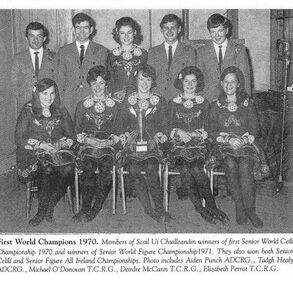 The first World Champs in 1970! The first World Champs in 1970! In North America, there are seven regional oireachtaisi competitions each year (held in and around November) put on by the regional branches of the Irish Dance Teachers’ Association of North America (IDTANA.) Each regional (ours is New England!) oireachtas holds a main championship, which SRL dancers are able to start competing in once they reach the Preliminary Championship level. Somewhere in between Oireachtas and Worlds are national competitions (North America’s is usually in July) that are generally secondary qualifiers for Worlds and open only to the highest level of SRL competitor: Open Championship dancers (see more about the levels in last week’s post!) Depending on the size, these competitions can last several days. Each region also holds team competitions, where dancers compete together in groups of 4, 8, or 16 in traditional céilí dances. SRL dancers are invited to the team program when they reach Beginner II and have shown dedication to their dancing through consistent attendance and regular home practice. The céilí dances are standardized by CLRG and are a great exercise in dancing in unison while keeping impeccable technique, all by depicting beautiful movement patterns with those on their team! Regional Oireachtaisi may also hold a subsidiary competition for up and coming dancers to gain experience on the bigger stage. In New England, we hold a traditional set competition where dancers prepare one of the seven standardized traditional set dances to perform for three adjudicators. Once they complete this hard shoe choreography (that’s been passed down generation to generation!), the dancers receive a rank or placement based on rhythm, timing, technique, and posture. At SRL, dancers in the Beginner II Hard Shoe classes are invited once they’ve mastered the set dance “St. Patrick’s Day.” 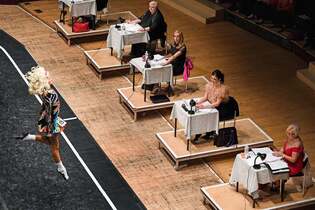 A competitor and adjudicators at 2018’s Worlds—slight changes in 48 years! A competitor and adjudicators at 2018’s Worlds—slight changes in 48 years! 2020 held a number of unique challenges and disappointments, and none more devastating in the realm of Irish dance as the cancellation of the Oireachtas Rince na Cruinne’s (or the World Irish Dancing Championships’) 50th anniversary this past year. While there’s technically no less than six other organizations that call their competition “Worlds,” the Oireachtas Rince na Cruinne overseen by the CLRG is the oldest running (fingers crossed for 2021!) and often referred to as the “Olympics of Irish Dance.” It’s considered by many to be the most prestigious competition available for Irish dancers, and in its early days (1975) was won by no other than Michael Flatley (yes, the “Lord of the Dance,” aka the first name the average person knows in connection with Irish dance and the first American to win!) The first Worlds took place in 1970 (see the pic above!) in Dublin’s tiny Coláiste Mhuire theater in Parnell Square and to this day is usually held over Easter week. The competition remained in Ireland (though the towns and cities rotated) until 2009, when America hosted the competition in Philadelphia. (Though it has now been held in the other countries where the highest concentration of Irish dancers live: Northern Ireland, Scotland, Great Britain, and Canada.) And while Worlds may have started small, 2019’s event (hosted in Greensboro, NC) boasted approximately 5,000 competitors and about 20,000 supporters. When you think of the fact that upon its founding in 1932, the CLRG counted only 32 teachers and 27 adjudicators (aka judges,) it’s easy to see that Irish dance really has become a worldwide phenomenon! While this “olympic” event can be, in many ways, the pinnacle of an Irish dancer’s career (just qualifying is a huge achievement!) there’s many avenues for dancers to keep their love of Irish dance alive after they retire from the competitive circuit. Beyond the numerous professional companies that tour around the world, helping Irish dance, music, and culture reach innumerable people, many Irish dancers become Irish dancer teachers (just look at our staff!) or open their own studios (like Miss Courtney!) There’s also degrees (both BA and MA) in Irish Dance Studies (once again—Miss Courtney’s a great example,) though many dancers pivot into dance-adjacent professions: nutrition, physical therapy, arts administration or fundraising (to name only a few)…it doesn’t have to become a hobby in a dancer’s adult life! This post is part of a series. Read Part 1 of Levels and Competitions here and Part 2 here. Check out the blog every Monday and Thursday for more posts about Irish history, dance culture, community news, and spotlights on our dancers, staff, and families—among other fun projects! And don’t forget to dance along with us on both Facebook and Instagram. 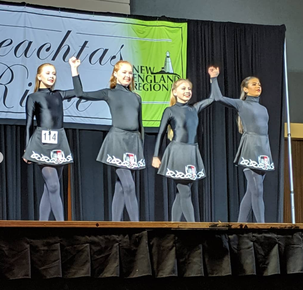 SRL dancers on stage at the New England Regionals in January 2020 SRL dancers on stage at the New England Regionals in January 2020 Levels and Competitions, Part 2 Many of our parents and dancers here at SRL are fully aware of all the ins and outs of Irish dance, and this post isn’t really for them (unless they’ve always been a little fuzzy on some of it—we won’t tell! It’s complicated!) This post is for our Beginner parents, our dancers just getting excited about maybe competing, or even the parent just checking out our website for the first time. (If that’s you, maybe check out our five previous posts in the series to catch you up to the present in Irish dance’s history!) Leveling Up Note: the following is a general overview and varies by region—this guide is for our region, New England, USA. Your dancer’s instructor is always the best authority on any and all information pertaining to the competitive track in your area and your dancer’s level, specifically. Competition level names and our class level names may share similar terms, but are not directly related. There’s a quote written on the mirror in the larger studio here at SRL: “You earn your medals in class, you pick them up at competition.” Today, we’re going to lay out how the levels work on the Irish dance competitive circuit, but these levels aren’t about the shiny dresses and big hair—they’re about the discipline, hard work, and practice, practice, practice. The CLRG says it best: The purpose…is to provide a structured framework within which dancers can progress towards an achievable goal. [It] provide[s] a strong foundation in Irish Dance by developing a candidate’s physical skills, stamina, expression, musicality and an appreciation and knowledge of the traditional dances and culture. But, the competition must go on! To explain this all in the most basic way: competing and placing in a feis (check out Part 1 if this term is new to you!) is how dancers move up from one level to another. But the rules and regulations involving that movement are anything but simple. 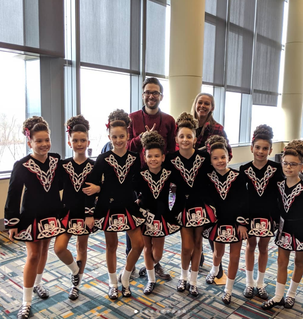 SRL dancers with Director, Courtney, and Instructor, Christian, at a regional competition in January 2020 SRL dancers with Director, Courtney, and Instructor, Christian, at a regional competition in January 2020 Let’s take a closer look at the lower and intermediate levels, usually called “grades”: Beginner Grade: This level is for dancers ages 6+ that are brand new to competing for their first calendar year in the competitive circuit. Once a dancer has learned the necessary skills and steps at class—two steps of reel and light jig—they are eligible to take part in their first feis at the Beginner level. It’s always exciting to get on stage with the possibility of earning a medal for their hard work in class! Advanced Beginner Grade: Students remain at this level until they place 1st, 2nd, or 3rd in a competition of at least 5 competitors. They move up when competing in the next calendar year and only within the type of dance they placed in—i.e. a dancer can be a Novice in the Slip Jig, but still an Advanced Beginner in the Reel. You are not considered in the next level fully until you move up in all your dances. Novice Grade: This is the level where things begin to get more complicated—the steps get more difficult, and the tempo of the music may be slowed in order to fit more and more advanced steps into the dancer’s performance. Novice dancers move up only if they place 1st in a competition of 5 or more dancers, though groupings of 20 or more dancers will move 1st and 2nd place up to the next level in that specific dance. This is the level where solo costumes (as opposed to your school’s costume) are allowed. 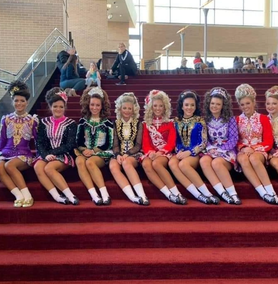 SRL dancers of Novice Grade and above in their solo dresses in 2019 SRL dancers of Novice Grade and above in their solo dresses in 2019 Prizewinner Grade: An advanced level competitor that has placed fully out of Novice Grade, but is working on rising to the level of Preliminary Championship Grade. The regional minimum to advance requires a dancer to place 1st in both a hard shoe and soft shoe dance in order to move up, but, as the final grade before Championships, SRL dancers are required to win all their Prizewinner dances in order to advance. Now, let’s explore the championship levels, where the dancing is extremely advanced and dancers begin to compete at the regional, national, and international levels: Preliminary Championship: Competitors at this level generally perform three dances: soft shoe, hard shoe, and a set dance. At the championship levels, the soft and hard shoe dances get longer than they were in the grade level—this requires more stamina and strength. At Preliminary Championship level dancers are invited to represent SRL at the regional championships held each November. A dancer must win 1st place twice in order to advance to the top level of Irish dancing—Open Championship—and qualify for Nationals. Open Championship: The highest competitive level. Similar to the prelim level, dancers perform a longer soft shoe dance and a longer hard shoe dance, along with a set dance. Set dances are a dancer’s solo piece that showcases their best strengths, impeccable rhythm, and musicality. If a dancer wins a 1st at this level, they may never return to competing in Prelim. Open Championship dancers are pursuing high placements at regional and national championships and working to qualify for the world championships (often competing at major championships--The All-Irelands, The All-Scotlands, The Great Britains, etc.—though this past year saw the cancellation of many.) 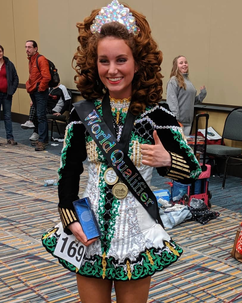 An SRL dancer qualifying for Worlds in 2019! An SRL dancer qualifying for Worlds in 2019! While most Irish dancers start young and finish their competitive careers by their early twenties, many feiseanna offer competitions for older age ranges, as well! SRL offers recreational adult classes in six-week night sessions—perfect for dipping your toe in the Irish dance world! Feiseanna are competitive, but they’re also a cultural touchstone—bringing together people of every walk of life to celebrate painstakingly developed skills that bring alive Ireland’s vibrant history and culture. This post is part of a series. Read Part 1 of Levels and Competitions here. Check out the blog every Monday and Thursday for more posts about Irish history, dance culture, community news, and spotlights on our dancers, staff, and families—among other fun projects! And don’t forget to dance along with us on both Facebook and Instagram. 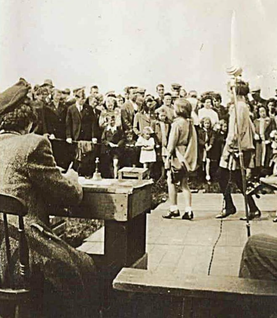 Vintage feis photos courtesy of @once_upon_a_feis on Instagram Vintage feis photos courtesy of @once_upon_a_feis on Instagram Levels and Competitions, Part 1 Many of our parents and dancers here at SRL are fully aware of all the ins and outs of Irish dance, and this post isn’t really for them (unless they’ve always been a little fuzzy on some of it—we won’t tell! It’s complicated!) This post is for our Beginner parents, our dancers just getting excited about maybe competing one day, or even the parent just browsing out our website for the first time. (If that’s you, check out our four previous posts here to catch you up to the present in Irish dance’s history!) A little recap: It was the Gaelic revival in the late 19th century, and the forming of the Conradh na Gaeilge (Gaelic League) in 1893, that helped Irish dance truly begin its journey from unrecorded folk tradition to the international, competitive art form it is today. With the League’s creation of a governing body specific to dance in the 1930s (Coimisiún Le Rincí Gaelacha—aka The Irish Dancing Commission or CLRG—still the primary governing body of Irish dance today,) Irish Dance Masters became a legitimate authority on a world stage (no pun intended.) The world of Irish dance as we know it today was built on this bedrock: the CLRG set down a series of rules and regulations to govern and standardize Irish dance (everything from steps and form to certifications for teachers.) This led to the creation of competitive opportunities to elevate its reputation, preserve and promote Irish culture, and nurture the art. And those competitions, rules, and regulations are what we’re here to discuss with you today! Feis Out the Best We’ve discussed feis and feiseanna (pronounced fesh and fesh-anna) before in this series—meaning simply “festival(s)”—they’re a long-standing tradition meant to celebrate and preserve Irish culture. Feiseanna today are still much the same (though in the dance world, they may only be a dance competition and not have as many outside vendors,) and vary in size: dance academies often hold inter-school class feiseanna, but there are also larger, regional feiseanna all over the world. These competitions are divided by both age and skill level (discussed next week!) and competitors are judged on a variety of technical and stylistic concerns such as timing, turn out, foot placement, deportment, choreography, rhythm…the list could fill this entire post. 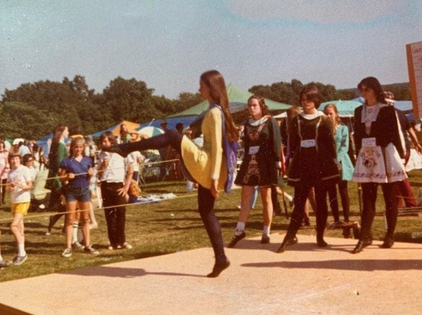 @once_upon_a_feis @once_upon_a_feis To put this all as simply as possible: dancers compete in multiple different dances divided into two major categories: hard shoe and soft shoe. From those larger categories, more specific ones emerge based on the music and its timing, in three broad categories: jig, reel, and hornpipe (though the slip jig is completely unique in Irish music and dance with a 9/8 time signature—we’ll explain further below!) Soft shoe dances include the reel, the light jig, the slip jig, and the single or hop jig, while hard shoe dances include the treble or double jig, hornpipe, and treble reel. Most feiseanna will have dancers beyond the earliest levels compete in soft shoe rounds, hard shoe rounds, and then a final round that’s often hard shoe, and often a set dance (more about that below.) Some feiseanna will include team or cèili (pronounced kay-lee) dances, as well. But how does a dancer get to be a competitor? Dancers begin preparing for competition at the earliest levels: every move they learn in their Beginner later becomes part of a dance. Beginners start with the basic reel and jig. Once a dancer has mastered these basic steps and has good control of their technique, they begin learning hard shoe with the treble jig (essentially a hard shoe version of the jig they’ve already mastered and know the music for—but with hard shoe skills and movements instead!) Hornpipe and traditional set dances are added as a dancer progresses in their hard shoe technique. Each dancer will gradually add more complexity to these basic dances, differing in rhythm and timing, as they develop as dancers—for example: over time, the basic steps of the reel, light jig, and slip jig are upgraded with more difficult choreography. Traditional set dances are unique, tune-specific dances that were choreographed long ago by Dance Masters in Ireland to exactly match the music. They have titles such as “St. Patrick’s Day,” or “Garden of Daisies,” and are largely universal around the world (though there are slight regional and studio variations.) This is different to other types of dances (reel, jig, slip jig, treble jig, and hornpipe) that are unique to each school. This is why (well, at least until 2020 forced many competitions online) videotaping Irish dance competitions has always been forbidden—you have to protect that choreography! 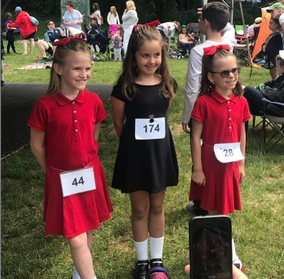 What the layperson needs to understand in order to hear the differences in dances/music really comes down to is the timing: different dances have differences in their beats per bar of music, as well as different emphasized beats. Here’s a little breakdown of the major groupings, though further designations into dances have even further and more complicated variations (check out a musical theory breakdown of each one here and click on each type of music to hear an example!): Reels: 4/4 time signature and will probably sound the most “normal” to a non-dancer as the beats are evenly emphasized. Can be detected if you can say “double decker, double decker” in time with the music. Jigs: 6/8 time signature, i.e. three beats per bar with the 1 and 3 emphasized (non-Irish dancers will recognized this as a waltz.) Detected by non-dancers by saying “carrots and cabbages, carrots and cabbages” in time to the music. Includes light jigs and treble jigs, but not slip jigs! Slip Jigs: 9/8 time signature, i.e. similar to the above jig but with three beats per bar and three eight notes in one beat (with the emphasis on the 5 and 9 beats.) This one can give a lot of dancers some difficulties at first—it has an almost rolling sound to it! Hornpipes: 4/4 time signature, like the reel, but with the 1 and 3 beats emphasized. There’s more variation here, but many hornpipes can be detected with “humpty-dumpty, humpty-dumpty.” Next week, tune in to the blog for the purpose of feiseanna competitions (besides fun!): rising through the levels or “grades.” This post is part of a series. Read more about how Irish dance's iconic form developed here. Check out the blog every Monday and Thursday for more posts about Irish history, dance culture, community news, and spotlights on our dancers, staff, and families—among other fun projects! And don’t forget to dance along with us on both Facebook and Instagram. 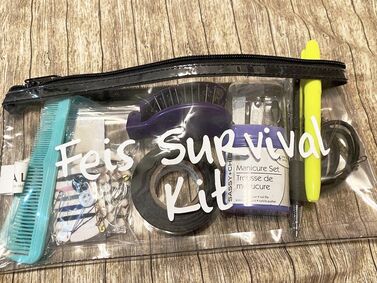 Feis Survival Basket Tonight we’re coming at you with a multifaceted gift idea for our competitive dancers: why not make them a “Feis Survival Basket”? We asked our parents and dancers to help us compile everything you could think of (and a few things you wouldn’t normally consider…) to bring to a feis. While we might not be attending as many feiseanna this year as in the past, these competitions were a vital part of your dancer’s life up until this year, and this gift has a bonus: a sense of normalcy, even as we learn to adapt. And, 2020 notwithstanding, we’re still figuring out ways to make sure more feiseanna can happen! So, consider helping make the rest of your dancer’s competitions this year as seamless as possible by providing them with something truly unique, special, and practical this holiday. (P.S. Don’t forget a basket! It can always be home décor later.) Though you’ll find some bigger business links throughout, we’ve tried our best to promote small businesses in the Irish dance community wherever possible and we hope you’ll join us in that goal! 1. The Look I can’t count how many times we were told the most important thing to bring to a feis is: everything. As in, make sure every part of your costume (and every member of your family) is in the car! Make it a little easier for them (and you!) to remember everything with a personalized checklist like the one pictured here. But the look isn’t just the costume, is it? Below, we’ll list some staples you can pick up at your local drugstore or order on Instacart, however you’re shopping these days—but by having these items already set aside for a feis, you and your dancer are much less likely to forget them! And why not make some of them extra special? Think about adding in an Irish dance themed makeup bag (makeup is definitely on the list of things not to forget if they wear it!), a personalized compact mirror, and/or a personalized hairbrush to make their gift extra special. You could also consider adding in a new number clip! Here’s a bejeweled option, and some that are less glittery, more Celtic in design. P.S. You can also check out our “For Your Competitor” installment of our “Irish Dancer Gift Guide Series,” for some additional add ons like customizable dress bags and shoes bags! Remember: -Your costume, socks, and shoes -Shoe buckles if desired -Makeup bag and makeup -Mirror -Hairbrush -Favorite lotion for legs and hands -Bobby pins -Favorite hairspray -Sock glue if they use it! -Hole punch for numbers -Number Clip 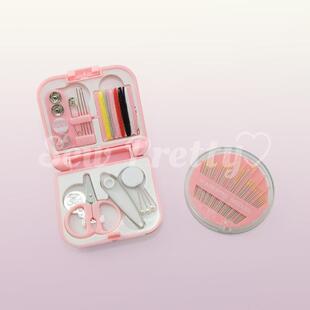 2. Rescue Items These items are the real heroes, and maybe the most necessary things to include since they’re not the most obvious ones. Below you’ll find a list of many, many kinds of tape among other items that might come to the rescue one day, but there are some items you can make fun as well! While there’s always a good, ol’ utilitarian travel sewing kit, there are some cute options out there too. Same with scissors—sure, any old pair would do. But why not add something more fun in the mix with their favorite color, SRL’s colors, or even some glitter? That way everyone knows that pair of scissors belong in their feis survival kit, not anywhere else! Remember: -Travel Sewing Kit -Scissors -Lint Roller -Electrical tape (black for shoe repairs!) -Gaffers tape -Rescue tape (2-sided fabric tape) in case a shoe catches a hem! -Safety pins in various sizes -Black shoe polish -Their preferred deodorant -Tide pen 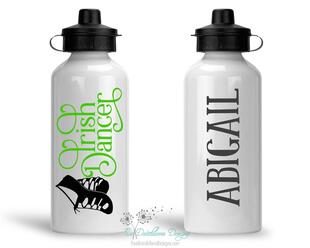 3. Staying Alert Okay, I was wrong. These items are the real heroes, and not just because they involve snacks. These are the things to remember to help get you, your dancer, and anyone else from your family that’s attending through a long, long day. You know your dancer’s favorite snacks and I’m sure they’d be delighted to have them, but there’s always another option…something brand new! Companies like Munch Pak or Try the World offer one-offs or subscription services for a variety of tasty treats sourced from all over the world—the UK included. And don’t forget the most important fuel for every dancer: water! (Also, depending on their age, coffee.) A personalized water bottle or travel mug (more suggestions in coming gift guides!) is the easiest way to make sure they’re picking up the right one—something more of a concern than ever these days. 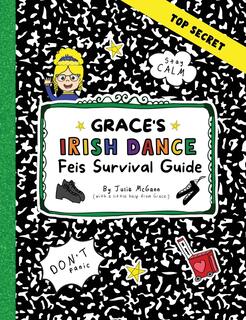 Beyond the three main food groups: snacks, water, and coffee, what else do you need to make it through? Something entertaining, of course! Include a pack of cards in the basket, an age-appropriate coloring book and colored pencils, or some books. While you can check out our Irish book recs here and here (and we have more for various age groups coming!) one fun option for those in the middle reader age range would be Grace’s Feis Survival Guide—what else could be more appropriate? Remember: -Snacks! -Water bottle -Coffee -Boredom killing activities (books, cards, etc.) 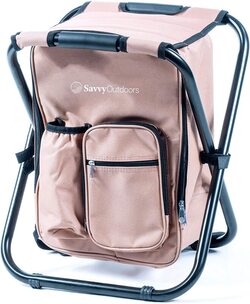 4. Extras Next we have all the extras to consider: extra socks, extra laces, extra crystals and glue for their Champion costumes…not the most exciting part of basket, but just as important! We sell socks in the SRL office (and can just charge your DSP, very hassle free,) and you know where to buy laces and the type of crystals they might need. The rest of these extras are for you as much as them: cash in case this brilliant idea fails and you still forget something, medicine for the inevitable headache that follows that many hard shoe performances, and wet wipes (because they’re always useful—especially after all those snacks.) One more thing to consider: somewhere to sit! Portable camp chairs are a great option for some, bleacher chairs another, and collapsible stools (this one has a cooler backpack!) for those who may be wearing their competition dress—you don’t want your dancer getting tired or messing up her costume before the performance. (Though, if you go with one of these seats, you may need a bigger basket!) Remember: -Extra socks -Extra laces -Extra crystals and glue if needed -Cash -Motrin/Advil -Wet wipes -Seats/Chairs 5. Your Support!
The idea of this gift isn’t really about buying your dancer a lot of tape, of course. It’s about showing your support for all their hard work and passion! To quote one of our amazing parents, make sure to “pack your patience and an attitude that can celebrate that needed first or comfort a disappointing day.” For something extra special, maybe pre-write them some notes to be opened upon completing their next few feiseanna—kind of like packing them an encouraging note in their lunch. You know what your dancer will need to hear in case of success or failure more than anyone else, even if the moment hasn’t happened yet! In our “For Your Littlest Dancer” installment of our gift guides, you can find some fun (and some custom!) stationery options—all Irish dance themed—but we all know the real gift is in your encouragement. This is bonus post of a series, come back next Saturday for the next installment or read the previous one all about Irish dancer décor here! And check out the blog every Monday and Thursday for more posts about Irish history, dance culture, community news, and spotlights on our dancers, staff, and families—among other fun projects! And don’t forget to dance along with us on both Facebook and Instagram. For Your Competitor Looking for the perfect Christmas gift for a child in your life who loves to dance, wiggle, or move? Our taster session will give them the gift of dance! This week on our Irish dancer gift guide, we’re concentrating on a different group of dancers: the feis enthusiasts! Is your dancer laser-focused on perfecting their moves before the next feis? Do they love moving up through the levels? Are you running out of places to put their ribbons? Then this is the guide is for you. And though you’ll find some bigger business links throughout, we’ve tried our best to uplift small businesses in the Irish dance community wherever possible and we hope you’ll join us in that goal! (Fun note: most of the items are customizable with SRL’s colors!) 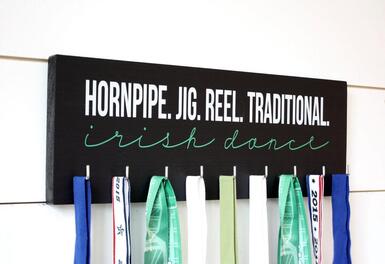 1. Ribbon Hangers This one’s a no-brainer for the dancer who has more feis ribbons than they know what to do with—who doesn’t need more organizational options in their life? There’s more options for these than I could possibly post here, so there’s an option to fit every dancer’s style. (And, if your dancer is more about dancing recreationally—or just younger—they make a pretty cute jewelry or coat hanger as well!) Additional Options: Dancing Girl Ribbon Hanger Personalized Hanger Comes in a Variety of Sizes 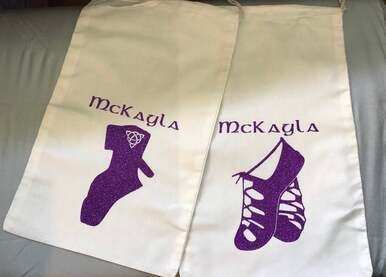 2. Shoe Bags One pair of ghillies looks like every other pair of ghillies—so help your dancer come home with her own shoes with these personalized Irish dance shoe bags! Beyond that obvious benefit, this will keep whatever they stepped in from getting anywhere near the rest of their things, as well as protect those expensive shoes. Additional Options: Personalized Dance Shoe Bag Ghillie-Shaped Bag Backpack Option 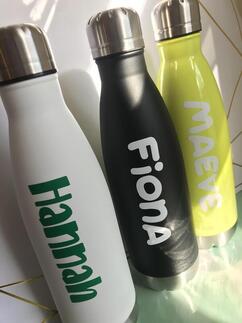 3. Water Bottles Almost everything in this post is able to be personalized, and for good reason—many kids and teens aren’t always the most careful with their personal belongings. These days, a personalized water bottle is more than a cute present, it’s a safety measure that will help your dancer steer clear of cross-contamination with their friends (or someone else with a blue water bottle.) The option pictured comes in a variety of fonts and colors, and there’s even male and female dancer decals you can add! Additional Options: Personalized Bottle with Shoes Lidded Cup with Straw Sport Top 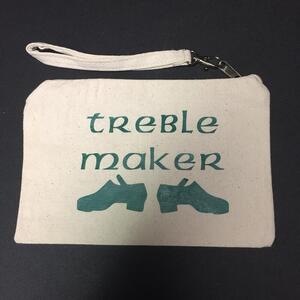 4. Makeup Bags Get your little treble maker something to keep false lashes and stage makeup in! Makeup bags run in that same realm of avoiding any cross contamination with friends, while also ensuring your dancer comes home with their own belongings. They can also be used as regular makeup bags, pencil cases, or general carryalls for those who prefer not get under those bright lights. Additional Options: “Feis Face” Bag “Hard Work Beats Lazy Talent” Bag “Eat, Sleep, Dance, Repeat” Bag 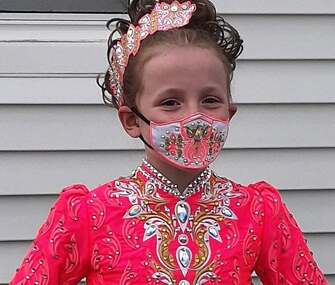 5. Custom Competition Mask and Tiara This gift idea goes the extra mile and really embraces the reality of all the 2020 feiseanna. This Etsy seller will work with you to create two pieces that matches your dancer’s costume perfectly, along with a coordinating wrist band to hold the mask! Not many people do this kind of specialty work, so below I’ve linked a few fun hair accessories (for practice days,) instead. Additional Options: Personalized Headband Ghillie Hair Bows Sequined “Dance” Shamrock Headband 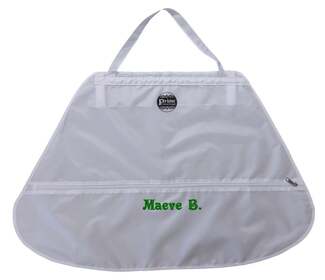 6. Dress Bags Those competition dresses have all kinds of embellishments and can be pretty pricey—might as well make sure they’re well protected! Note the “lemon wedge” shape, perfect for keeping that full skirt as neat as when it was hanging in the closet. See below for a personalized garment bag versus dress bag—perfect for our male dancers’ costumes! Additional Options: With Matching Duffel Customizable Sizes with Claddagh Personalized Garment Bag This is Volume II of a series. Come back next Saturday for the next installment or read last week’s for some gift tips for our youngest dancers. And check out the blog every Monday and Thursday for more posts about Irish history, dance culture, community news, and spotlights on our dancers, staff, and families—among other fun projects! And don’t forget to dance along with us on both Facebook and Instagram. 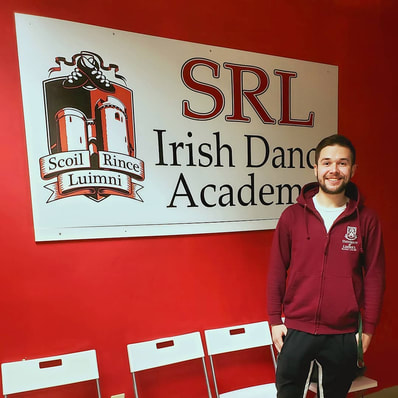 Scoil Rince Luimni is thrilled to welcome Christian Cairone TCRG to our studio family! Christian has been Irish dancing since he was 3 years old. He trained under Irene and Maureen Horgan who helped instill the love and passion for dancing he has today. While there, he assisted teaching with all levels of classes which helped to increase his love of dancing and teaching. Christian has competed around the globe with career highlights including: becoming Senior Men's Oireachtas champion, placing 4th at the All Ireland's, and medalling at both the North American Championships and the World Championships. At the 2018 World Championships, he had the opportunity to perform with the Fusion Fighters during their performance and would love to dance in a professional show in the future. Since passing his TCRG exam in January 2018, he is focused sharing his love and passion with his dancers and helping them to reach their goals. Aside from dancing, Christian majored in Culinary Arts and Culinary Nutrition at Johnson & Wales University. He is currently working on becoming a Registered Dietitian to eventually specialize in Sports Nutrition to help dancers understand proper nutrition and to also give them easy recipes to use as well! We are excited to have additional feedback, expertise, and support for all of our dancers as well as bring our growing contingent of male dancers a role model they can aspire to emulate in their dancing! 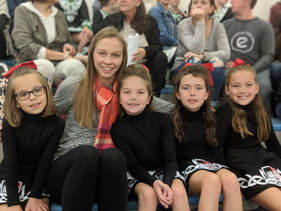 To all of my amazing dancers on the (almost) eve of the Oireachtas, I am so proud of you. Thank you for your hard work in preparing for this big event and I want to let you know how honored I am to be part of your team. After months of classes, practices, private lessons, competitions, and an emotional breakdown here and there, I want you to know that no matter what happens you’ve already won. There are not many kids these days that are willing to make the sacrifices you have made to excel at their sport. There are not many kids dedicated enough to something to keep putting in the work day after day, week after week, when the reward isn’t guaranteed and is often far in the future. As long as you stay calm, project confidence, dance like you do in class, and show great sportsmanship, there is nothing more I can expect or ask of you. Please let that comfort you and lighten the load you feel on your shoulders. I’m sure you have put greater pressure and expectation on yourself and I don’t wish to add to that. Remember to be kind to yourself and be your own number one fan. I hope that you can celebrate your result no matter what your ranking is - after all, this is one day among many in your dance journey. This is one little mile-marker along the marathon that is your continual self improvement and you HAVE improved just by peaking for this event. Even if you feel a sting of disappointment, remember that it’s okay to feel that pain temporarily but it’s also important to not let it keep you down or become a limiting belief. Instead, dust yourself off and be ready to cheer on your friends. Just because you’re not happy with your own results doesn’t impact your ability to support others. Whether you win the whole thing or fall all the way to the bottom of the results, we turn the page together at the conclusion of the Oireachtas. Either way we move on to an improvement season, learning new choreography, and setting new goals and my opinion of your potential of a dancer does not change based on the outcome of this weekend. Your power is in your ability to take your result and use it for motivation. Finally, say thank you to your parents. While they may not receive a medal for their efforts, they should not go unnoticed or under appreciated. Together, we all stand behind you on your team and they make sure you get to class, get to competitions, have the supplies and equipment you need, and experience everyday’s ups and downs along with you. Now go out there and be fiercely you! You can do this, I believe in you! Courtney Scoil Rince Luimni Irish Dance Academy, based in South Windsor & Farmington Connecticut, will have 31 dancers representing our school at the 2018 New England Regional Oireachtas held from November 16-18, 2018 in Hartford, Connecticut. Our dancers will be competing against the best of New England across three disciplines for regional ranking, National qualification for the North American Irish Dance Championships in July 2019, and the World Irish Dance Championships in April 2019. Dancers in the Traditional Set Dance competitions will be competing in the lower-tier competition designed to give up and coming dancers an opportunity to compete on the big stage against all the New England dancers in their age group. SRL is well represented in the traditional set dance competition with dancers hailing from:
The premier event in the solo championship which is for the highest level dancers that have climbed the ranks of competitive Irish dance over many years. These dancers are looking beyond improving their ranking and looking to place in the top 50% to be awarded their ranking on stage or qualify to a higher championship such as the North American Irish Dance Championship or World Championship. SRL will be represented in the solo championships by dancers from:
In the final team discipline, dancers perform standardized group dances called “ceilis.” Team competitions require precision in every movement, pattern, and step as each team is judged solely on execution. We have four 4-member teams that will compete in the 4-Hand Team competition:
We also have an 8-member team eyeing a result that would move them forward to the World Championships in Greensboro, North Carolina in April 2019. The girls competing on this team are: Gabby Gorman & Ellie Diver (Farmington), Emma Magnani & Emma Feeley (Springfield), Paige Miele (Westfield), Emily Messier (Glastonbury), Mackenzie Richards (East Longmeadow), and Cayla Batz (Coventry). Please keep all of our dancers in your thoughts and sending them positive vibes as they head into competition this weekend. These dancers have been working since the spring to fine tune their dances for their moment on stage and we wish them the very best of luck! 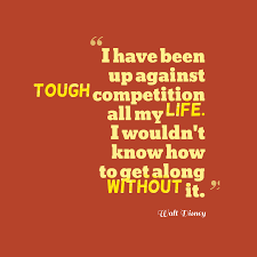 The fall competition season is well underway and it’s a roller coaster of emotions for our intermediate and advanced dancers as they inch closer and closer towards the biggest competition of their season, the Regional Oireachtas. While we do everything we can to prepare both in class and at home, not every feis is smooth sailing or rewards each dancer for their hard work. It’s easy to love dancing and competing when you’re rewarded for your efforts - but what about when dance doesn’t always love you back? You might be doing all the right things - taking in your corrections at class, practicing at home, getting enough sleep, fueling your body for success and still come home empty handed or disappointed with the results you received. You might wonder, what am I doing wrong? Why are my friends being rewarded and not me? It’s a painful reality but one that exists. I’m here to tell you it’s normal - necessary, even - for truly appreciating what it takes to go after something you want. If you worked hard and were rewarded every time, you’d leave feeling happy but you also might not work as hard next time. When you have to really fight for what you want, you appreciate it so much more when it finally happens and you’re ready for the next challenge. I recently asked a group of students, “what do you think would happen if you won all the time?” and the responses were very insightful:
Please join us in wishing the very best of luck to our six dancers attending the North American Irish Dance Championships this week in Orlando, Florida. They have qualified through the regional championships and/or achieving Open Championship status, the highest level within the competitive ranks.
They will represent Scoil Rince Luimni, Connecticut/Massachusetts, and the New England Region in the championships against the United States, Canada, Mexico as well as dancers traveling from Australia, Ireland, the UK, and beyond. We are proud of their hard work through their preparation and are looking forward to their training shining on stage. Colleen Williams, 11, of Amston, CT and Bella Jensen, 11, of Somers, CT will compete in the Girls Under 12 division on Wednesday July 4th. They are best of friends and are practically inseparable, making training enjoyable for them while they make each other laugh almost constantly. It will be Colleen's second time attending the NAIDC and Bella's debut. Emma Magnani, 15, of Springfield, MA and Kayla Purcell, 15, of Hebron, CT will compete in the Girls Under 15 division on Monday July 2nd. Both are first time qualifiers and looking forward to experiencing this heightened level of competition together. Tara Lynch, 17, of Cheshire, CT will compete on Sunday July 1 in the Girls Under 18 division. She is a second time qualifier and learned a lot at her previous NAIDC in New Orleans last year. She is bringing her wisdom and experience with her this year and loves to perform on the big stage. Lindsey Hoffman, 18, of Columbia, CT will compete on Saturday June 30 in the Girls Under 19 division in her fourth appearance at the championships. After recovering from injury last year, she is giving it everything she has and brings more maturity and perspective than ever before. Each division has approximately 130 - 180 competitors and the top 50% of each group will be recalled to dance a third round before being awarded at the end of each day. No matter the outcome, we are proud of each dancer for qualifying for this major championship and their growth as dancers, performers, and competitors in their preparation for this week. You can follow the highlights on our Facebook page or for a more detailed look at each day, you can follow us on Instagram through our posts, stories, and IGTV. From November 17 - 19, droves of New England’s best Irish dancers descended upon the Connecticut Convention Center in Downtown Hartford for the annual regional championships. A home game for SRL, our 29 dancers who reached our qualification standards competed for placements across three divisions - traditional set, solo championships, and teams. Beginning with our traditional sets, SRL had many first time competitors competing in this division designed to give intermediate dancers the opportunity to test their skills against others from the New England states. We are proud to say that of our 16 traditional set competitors, 11 of them placed in the top 50% to appear at the awards ceremony. Of those 11 dancers, here are their results: Gabby G - 3rd place Isabella R - 4th place Lilly B - 6th place Ciara D - 7th place Cara Maye W - 9th place Ellie D - 9th place Paige M - 10th place Audrey M - 14th place Jane C - 15th place Mairi C - 19th place Cassidy T - 19th place In the solo championships, dancers from the two championship levels - preliminary and open - compete for placements in the top 50%, berths to the North American Irish Dance Championships, and later qualification to the World Championships. SRL had 9 solo championship competitors with 4 earning the honor of a recall and competing in the third round of competition. Three were awarded on stage: Colleen W placing 19th and qualifying for NAIDC 2018 Emma M placing 41st Kayla P placing 48th Tara L, Lindsey H, and Rebecca K are pre-qualified for NAIDC 2018 in Orlando, FL On Sunday, our 3 four-hand teams competed as well as our eight-hand. This was our first big team year after sending a pilot team in 2016. With stiff teams competition in the New England Region, we are thrilled that our Girls U12 team placed 14th! Well done to Bella J, Colleen W, Irelyn L, and Audrey M for their excellent teamwork and beautiful dancing. Our youngest four-hand was just one place away from making the 50% cut and our mixed four-hand was just three places away. Our eight-hand kept pace with the best of them and made SRL proud. We have several dancers right in the mix to qualify for the NAIDC 2018 and we’re looking forward to our upcoming winter feis season! 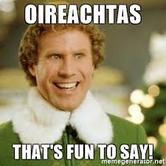 With the New England Oireachtas coming to Hartford, this provides an opportunity for our dancers to have their local friends and family come see them compete without having to drive for hours round trip. I’m sure your favorite dancer would love your support, but here are a few things to keep in mind:
If you’re new to Irish dance checking out the Oireachtas, it can be overwhelming. Keep in mind that this is the top percentage of dancers in our region and it takes time and hard work to reach this point. At SRL, dancers are not required to compete so if this is too much you’ll never have to step foot into this little world again - you can enjoy performing and learning in class without stepping foot into the competition world. The 2017 New England Oireachtas (or Irish dance championship) is coming to our home city of Hartford from November 17-19th. Over the Oireachtas weekend, competitors from all six New England states will gather to compete for titles and placements in three main disciplines - solo championships, traditional set, and ceili.
Our solo championship competitors will be vying for positions within the top 50% to earn placements and medals at the evening award ceremony. From there, competitors will also look to earn berths to the 2018 North American Championships in Orlando, FL and/or the 2018 World Championships in Glasgow, Scotland. Our solo championship representatives are Colleen Williams of Amston, CT & Isabella Jensen of Somers, CT in the Girls Under 11 category, Emma Feeley of Springfield, MA, Emily Messier of Glastonbury, CT, Emma Magnani of Springfield, CT, Kayla Purcell of Hebron, CT, and Mackenzie Richards of East Longmeadow, MA in the Girls Under 14 category, Tara Lynch of Cheshire, CT in the Girls Under 17 category, Lindsey Hoffman of Columbia, CT in the Girls Under 18 category, and Rebecca Kall of Farmington, CT in the Ladies Under 22 category. Lynch, Hoffman, and Kall are already pre-qualified to attend the 2018 North American Championships. Our traditional set dancers are preparing to compete in the solo championship category in the future by showing mastery of their technique, timing, and musicality in one of the seven traditional set dances. These dances stem from the dance masters that would travel from village to village or county to county in Ireland teaching steps to men, women, and children. Various versions were passed on and preserved and are still prominent in the dance tradition today. Representing SRL in various age groups include Isabella Robinson, Jane Carty, Nora Carty, Mairi Carchrie-Leigh, and Irelyn Lash, all of South Windsor, CT, Cara Williams of Amston, CT, Ciara Doyle and Abby Quinby of Windsor, CT, Audrey Miner of Tolland, CT, Paige Miele of Westfield, MA, Katelyn Hall of Manchester, CT, Cassidy Thompsen of Ellington, CT, Lilly Bluestein of Broad Brook, CT, Ellie Diver and Gabby Gorman both of Farmington, CT, and Kelly Beyus of Harwinton, CT. In the ceili category, dancers compete on teams of 4, 8, 16, or in Dance Drama. The 4 and 8 hand ceilis are another passed down, traditional aspect of Irish dance. A book of 30 dances must be mastered as part of the teacher certification process and features in the competitive repertoire to preserve historic pieces of Irish dance. The 16 hands and Dance Drama competitions represent the more modern interpretations of Irish dance with new, innovative, teacher generated choreography. SRL has three four-hand ceilis; our U8s featuring Isabella Robinson, Jane Carty, Nora Carty, and Cara Williams, our U10s featuring Michael Jensen, Mairi Carchrie-Leigh, Ciara Doyle, and Angelina Mundo, and our U12s featuring Isabella Jensen, Colleen Williams, Irelyn Lash, and Audrey Miner. SRL also has a eight-hand ceili in the Under 15 section featuring Gabby Gorman, Kayla Purcell, Emily Messier, Lilly Bluestein, Ellie Diver, Paige Miele, Cassidy Thompsen, and Mary Gombos. Competitions will be held at the Connecticut Convention Center all day November 17, 18, and 19. Admission is free for spectators and we would love your support! SRL qualified four dancers to compete at the 2017 North American Championships in New Orleans, Louisiana from July 4 - July 9. To qualify for the North American Championships dancers must advance to the top competitive level of Irish dance, "Open Championships," or place highly enough at the regional qualifying event. Our 2017 North American Championship qualifiers were: Rebecca Kall (Farmington) in Ladies U22, Lindsey Hoffman (Columbia) in Ladies U18, Tara Lynch (Cheshire) in Girls U17, and Colleen Williams (Hebron) in Girls U11. Our qualifiers trained tirelessly through the spring and early summer to put their best foot forward on stage. They made our entire school so proud and the experience gained by our qualifiers has benefited both their personal growth and the growth of their classmates who hope to qualify themselves this November.
The 2016 New England Oireachtas was held in Providence, RI from November 18-20 so New England's top dancers across three divisions could go head to head. SRL took 13 dancers and 1 team after many months of preparation, hard work, and sacrifice. Our dancers brought their best to the stage from our little first timers to our championship veterans. We had 4/5 soloists make the cut for top 50% of their age group with 3 qualifiying to the North American Championship to be held over the July 4th holiday in New Orleans, Louisiana! Our traditional set squad consisted of almost exclusively first timers to the Oireachtas stage and their performances made us so proud! We had 3 dancers make the final cut for awards on stage with some fantastic results! Our final division of competitors was our first ever ceili team! Our girls 4-Hand are the trailblazers for our school's ceili/teams program that will only grow from here. Teams are such an important part of Irish dancing and we hope to have all dancers experience this side of dancing in the coming years. Our team did not make the cut for awards, but they were pretty close to the recall line for a team that has only been together for a short time. Well done girls! Next year the Oireachtas comes to our home city of Hartford! We plan to include even more first timers and teams to allow our hardworking dancers to opportunity to compete in front of a home crowd.
The New England Oireachtas is the regional championships for dancers living in the six New England states. It serves as a ranking competition for dancers in all categories and for dancers who place highly enough to earn places in the 2016 North American Championships and 2016 World Championships. Dancers can compete in one of two divisions - traditional set or solo championships. In the traditional set division, dancers in the intermediate levels compete one round on stage to gain experience on the large stage to compete at the championship levels in the future. SRL sent three traditional set dancers to the 2015 New England Oireachtas. All three placed in the top 50% of their competition to earn awards on stage. In the 17&Over age group, Siobhan Delorey of Falmouth, MA/Springfield MA placed 6th. In the Under 11 age group, Lilly Bluestein of Broad Brook earned 26th place. In the Under 9 age group, Colleen Williams of Hebron danced her way to the top of the podium earning first place! In the solo division, where national and world qualifying places are up for grabs, dancers compete two rounds before a final cut is made to determine the final places. All three SRL dancers recalled to the final round and were eligible for awards (in most competitions, this includes the top 50% of competitors). In the Under 19 age group, Rebecca Kall of Farmington, CT recalled and ranked 9th to earn a berth to the North American Championships in Orlando, FL this July. In the Under 16 age group, Lindsey Hoffman of Columbia, CT placed 38th and will join Rebecca at the North American Championships. In the Under 15 age group, Tara Lynch placed 45th and is eager to join Kall & Hoffman in Orlando.
In May, SRL held our first spring Showcase at the Irish American Home Society in Glastonbury, CT. The Showcase included performances by all SRL dancers, dinner & dessert for our families and friends, some ceili dancing, and fabulous raffle prizes donated by sponsors in our local community and the Irish dance community. The Showcase also served as a major fundraising event for the SRL Parent's Association which supports our dancers by providing stipends for costumes, competition, travel, and equipment. We are already looking forward to next year's event! 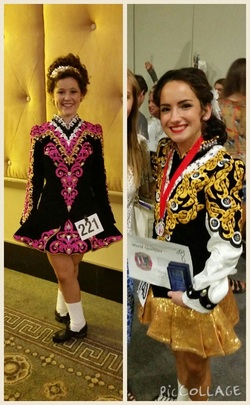 Lindsey (left) & Brigid (right) Lindsey (left) & Brigid (right) After the Showcase, dancers finished the final classes of the year before a well earned summer break. For some of our dancers, these classes were the final push before departing for the North American Irish Dance Championships held in Providence, Rhode Island. The NAIDC is an international major competition that serves as a qualifier for the World Championships in 2016. Dancers compete against the best from the USA, Canada, Mexico, Ireland, UK, Australia, and further afield for qualifying positions. Two SRL dancers represented us at the 2015 NAIDC, Brigid Cazzetta and Lindsey Hoffman. Brigid placed 16th and qualified for the World Championships and Lindsey danced beautifully at her first major debut. We are so proud of them and can't wait to see how Team SRL does at the upcoming New England Oireachtas in November. |
SRL NewsFind all of our latest news on our Scoil Rince Luimni Facebook page! Categories
All
Archives
August 2022
|
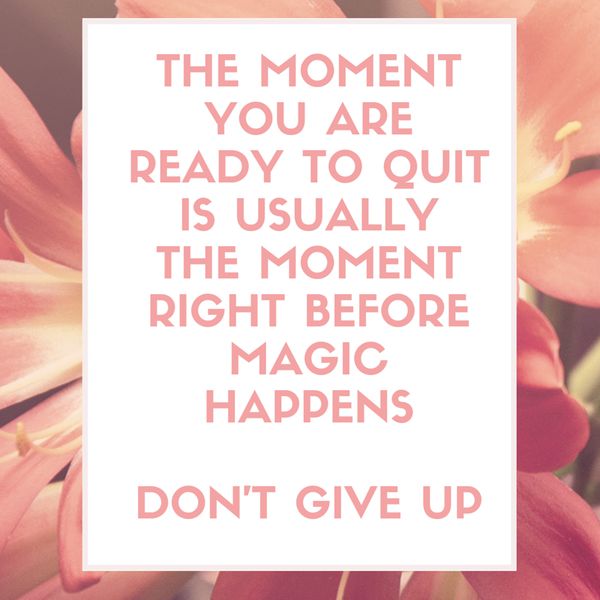
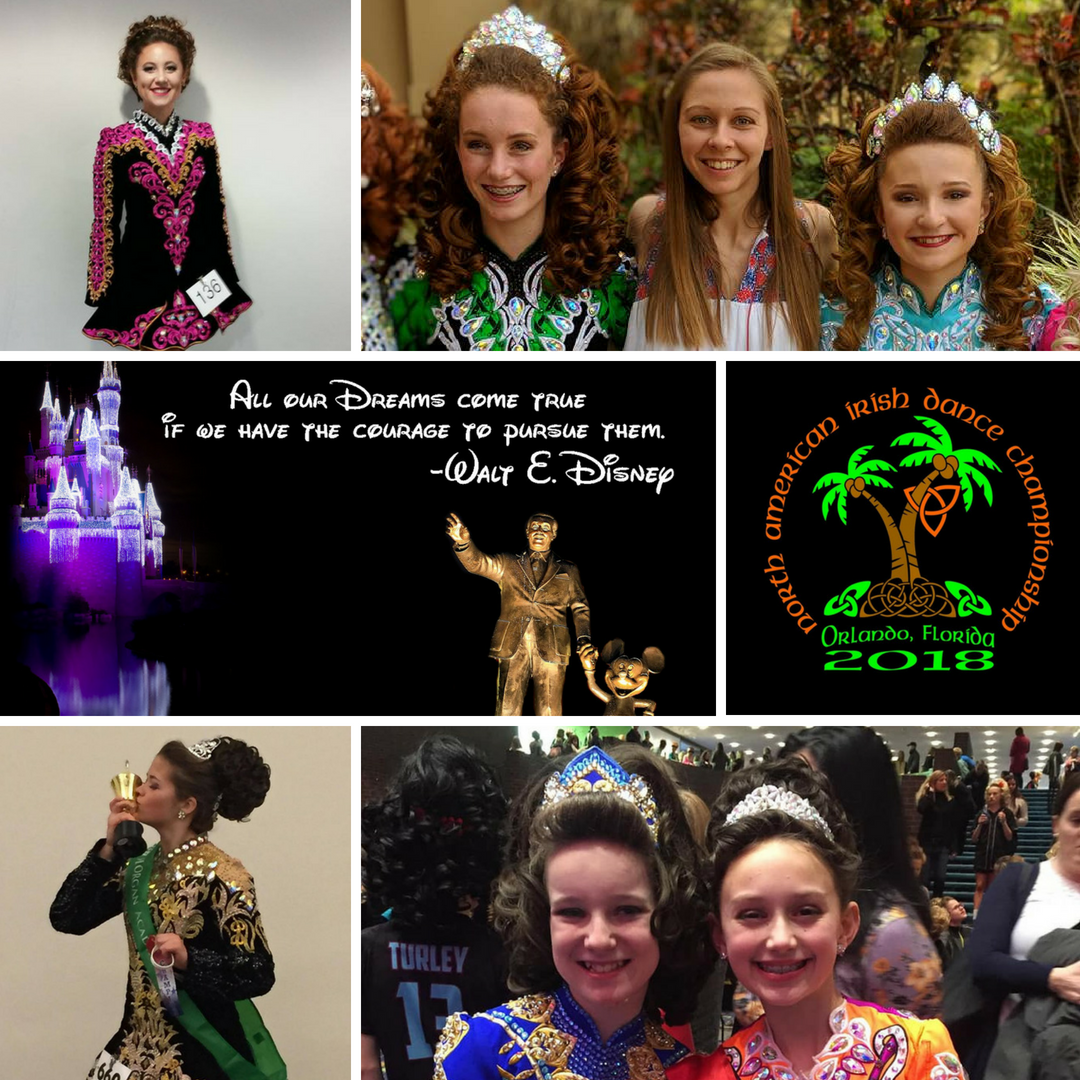
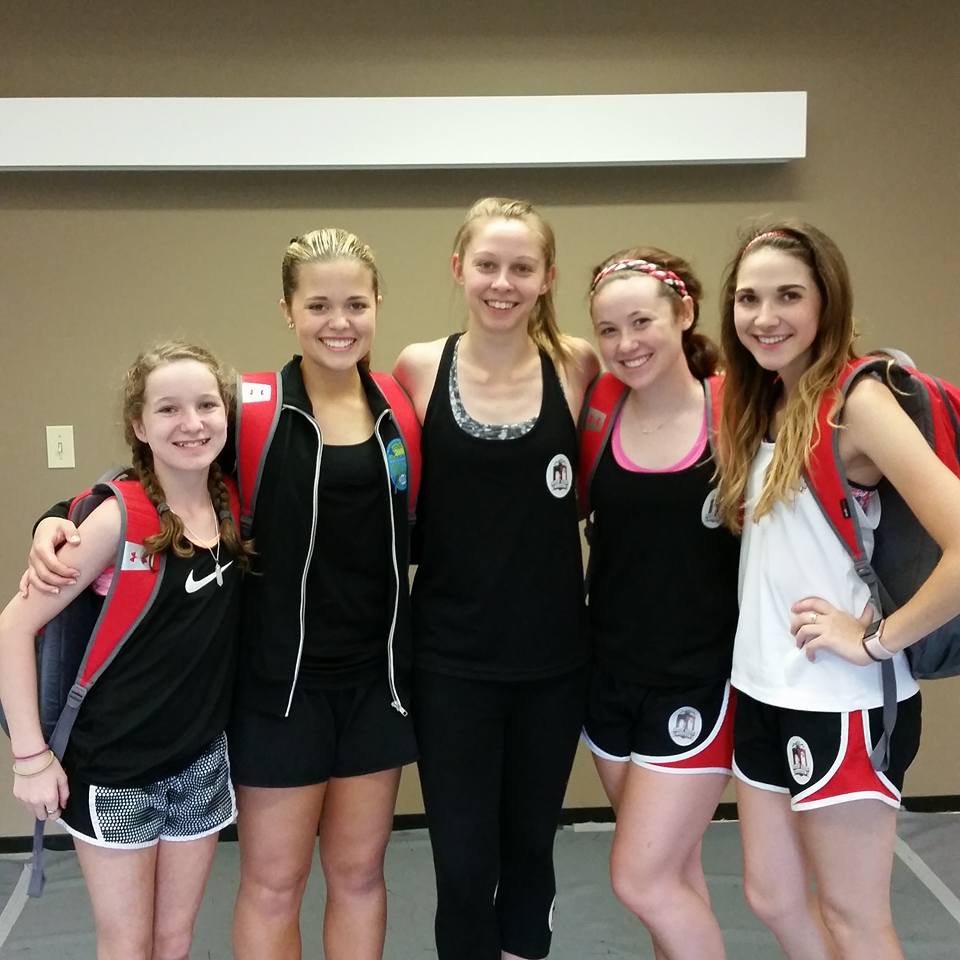
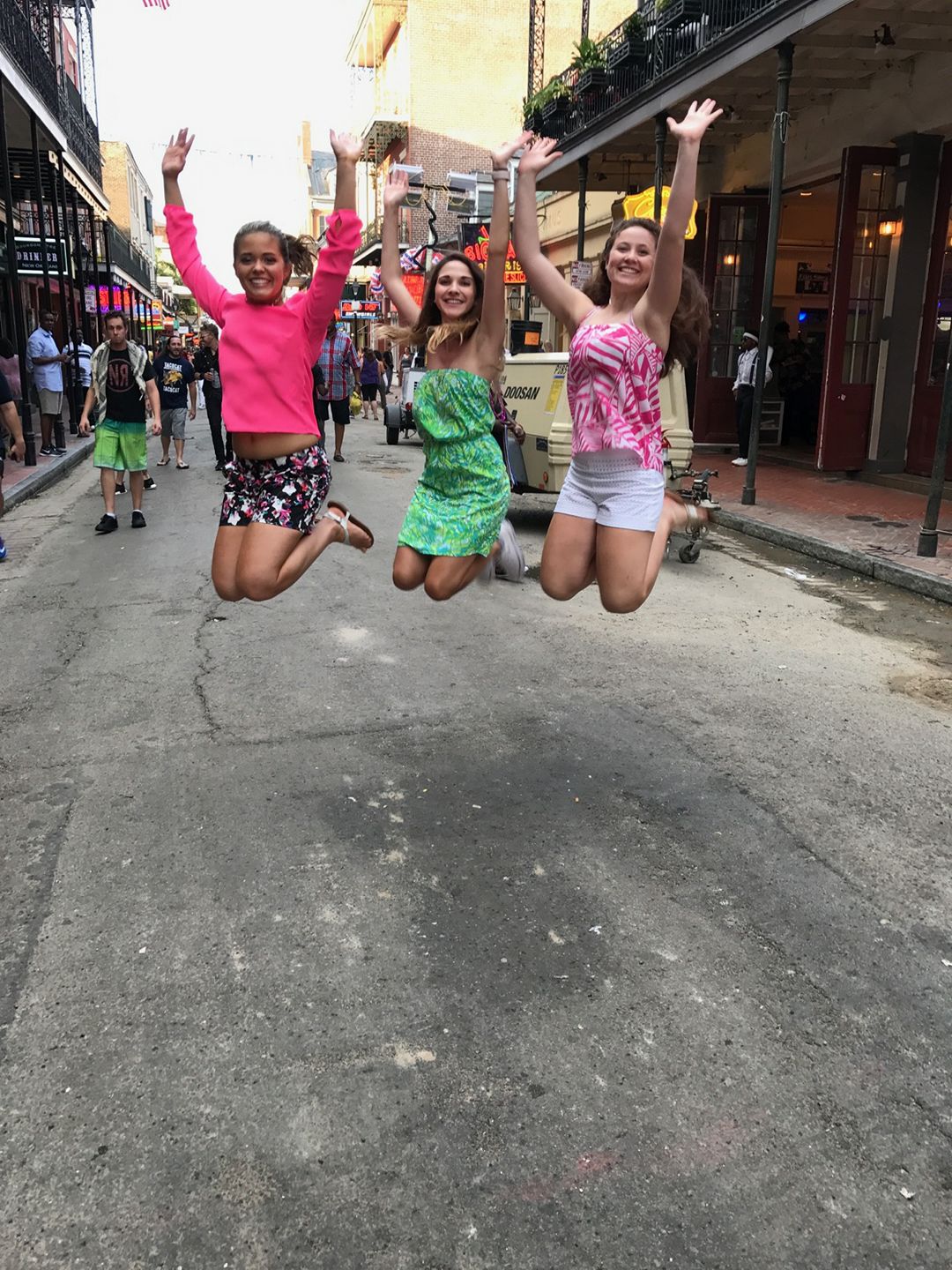
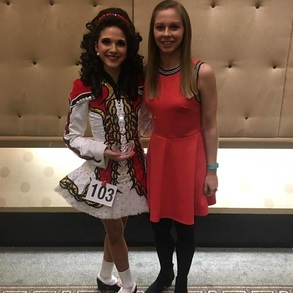
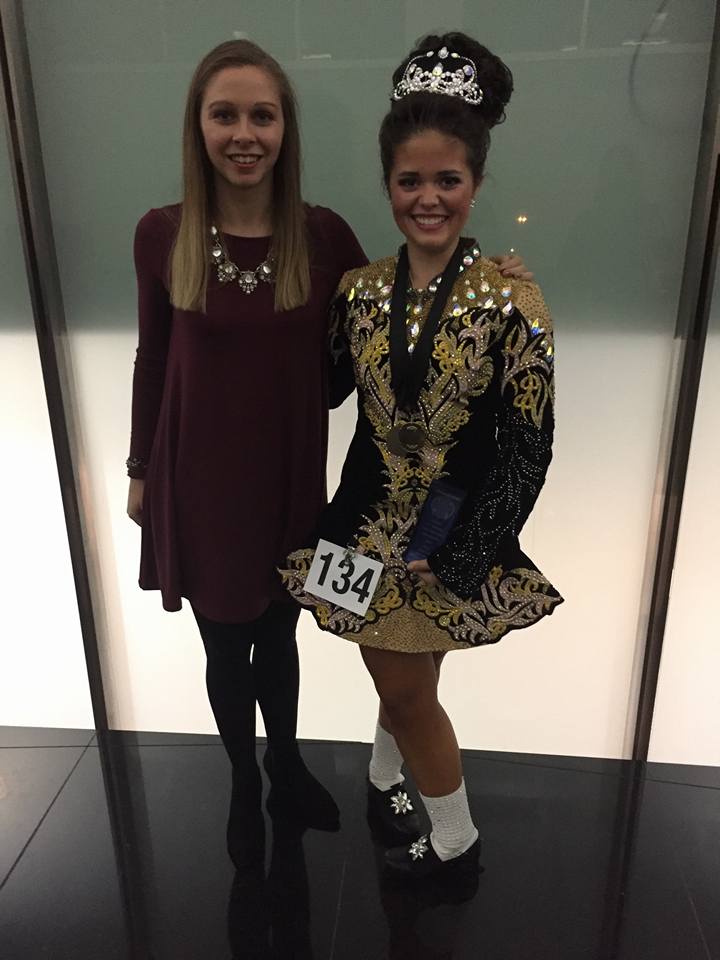
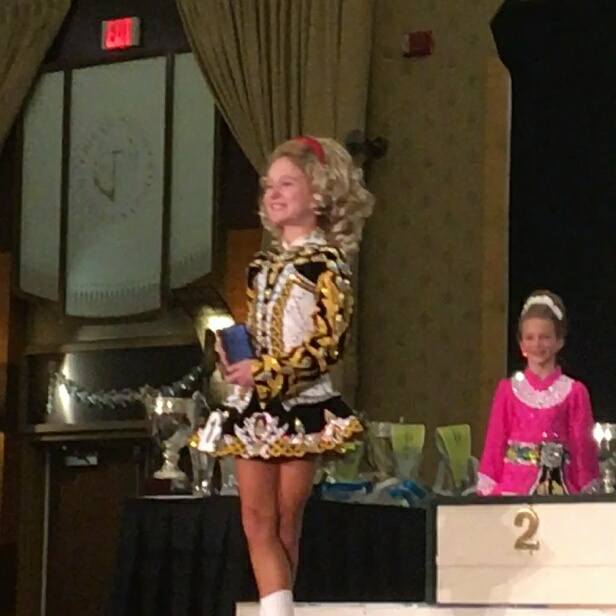
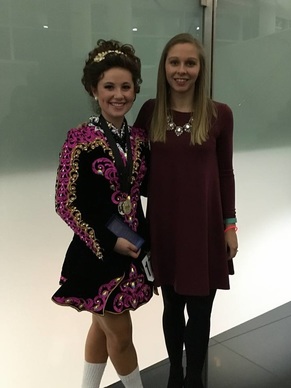
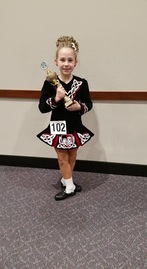
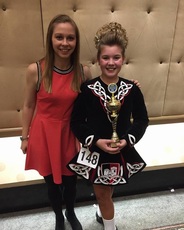
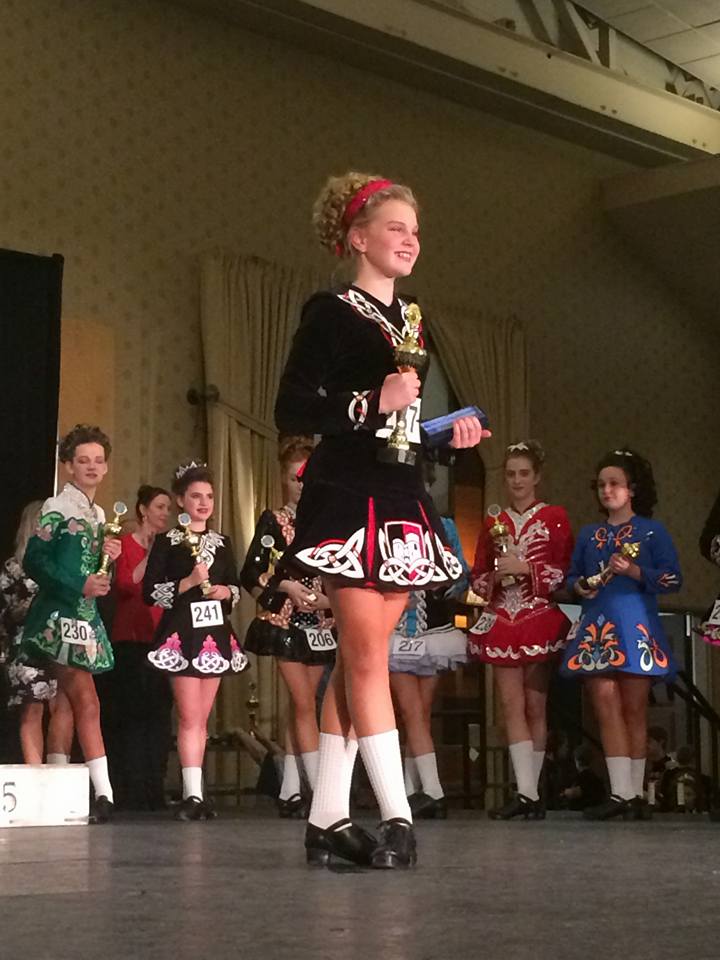
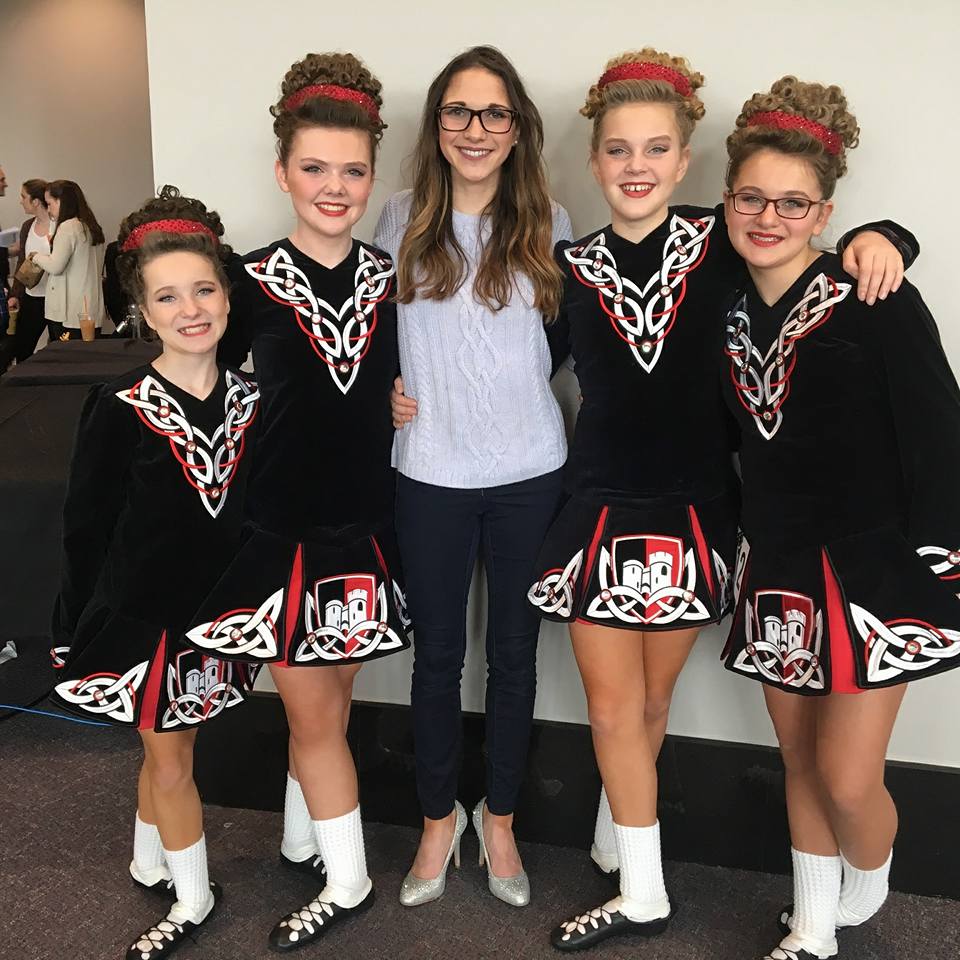
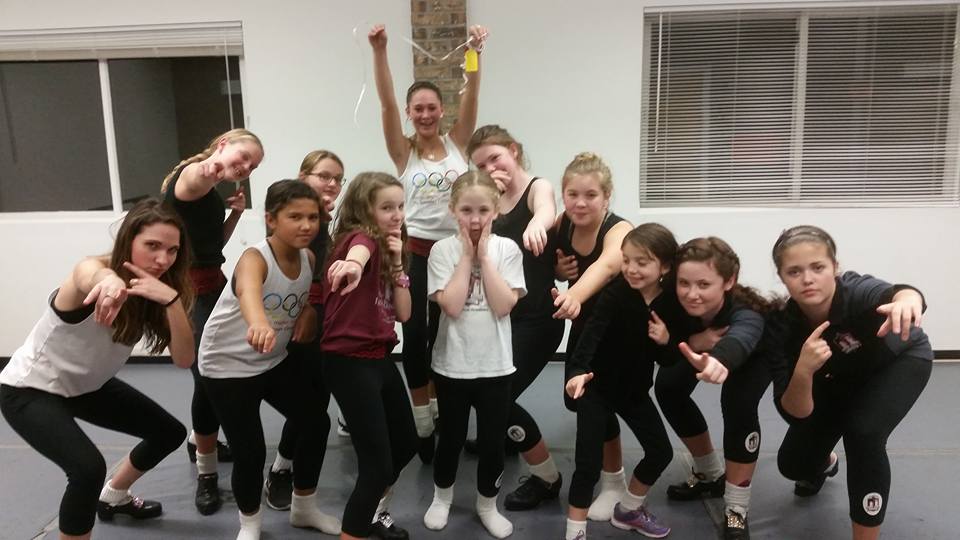
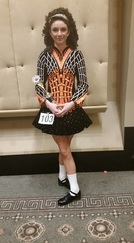
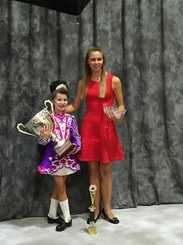
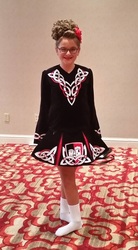
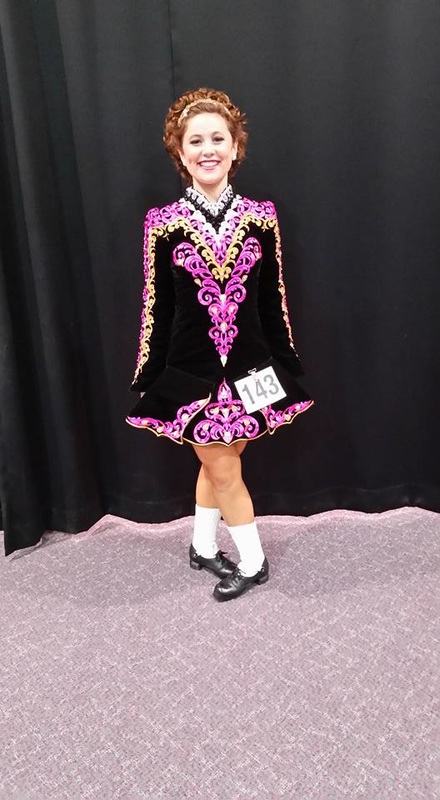
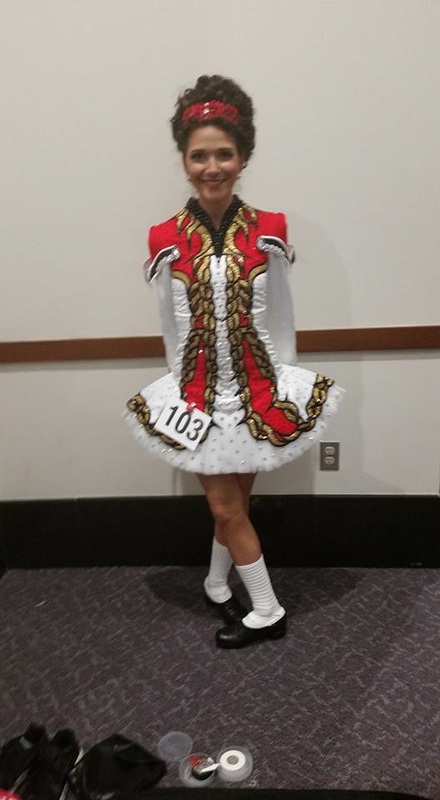
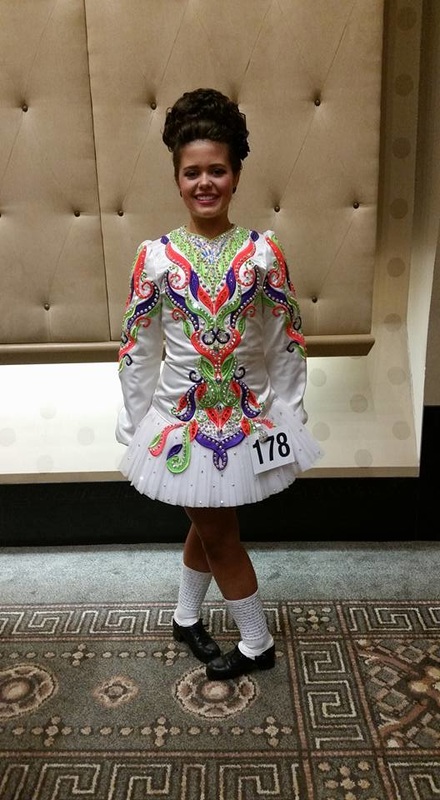
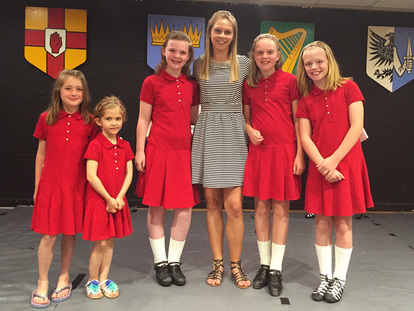
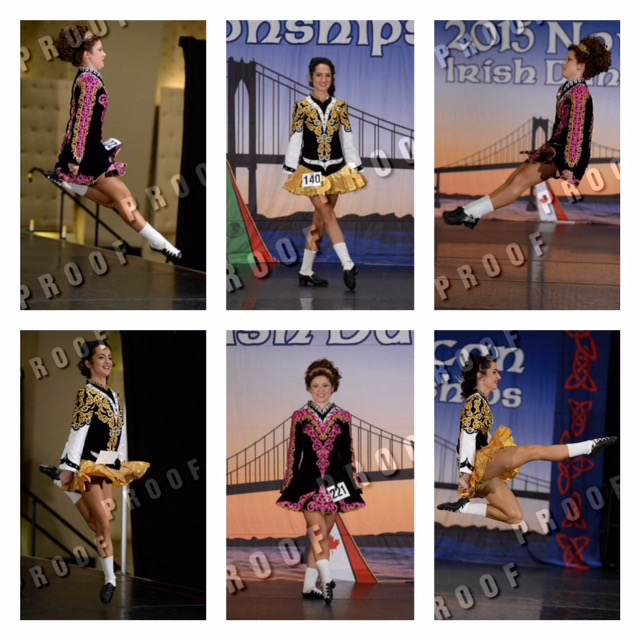
 RSS Feed
RSS Feed